INDESIT DSG 263 User Manual

Istruzioni per l’uso
LAVASTOVIGLIE
IT |
|
|
EN |
|
FR |
|
|
|
|
|
|
|
|
|
|
Italiano, 1 |
English,13 |
Français, 25 |
|||||
|
|
|
|
|
|
|
|
DE |
|
|
NL |
|
ES |
|
|
|
|
|
|
|
|
|
|
Deutsch, 37 |
Nederland, 49 |
Español, 61 |
|||||
|
|
|
|
|
|
|
|
PT |
|
|
|
|
|
|
|
|
|
|
|
|
|
|
|
Português, 73
DSG 263
DSG 051
Sommario
Installazione, 2-3
Posizionamento e livellamento Collegamenti idraulici ed elettrici Avvertenze per il primo lavaggio Dati tecnici
Descrizione dell’apparecchio, 4
Vista d’insieme Pannello comandi
Caricare i cestelli, 5
Cestello inferiore
Cestello delle posate
Cestello superiore
Avvio e utilizzo, 6-7
Avviare la lavastoviglie
Caricare il detersivo
Opzioni di lavaggio
Programmi, 8
Tabella dei programmi
Brillantante e sale rigenerante, 9
Caricare il brillantante Caricare il sale rigenerante
Manutenzione e cura, 10
Escludere acqua e corrente elettrica Pulire la lavastoviglie
Evitare i cattivi odori Pulire gli irroratori
Pulizia filtro entrata acqua Pulire i filtri
Se ci si assenta per lunghi periodi
Precauzioni e consigli, 11
Sicurezza generale Smaltimento
Risparmiare e rispettare l’ambiente
Anomalie e rimedi, 12
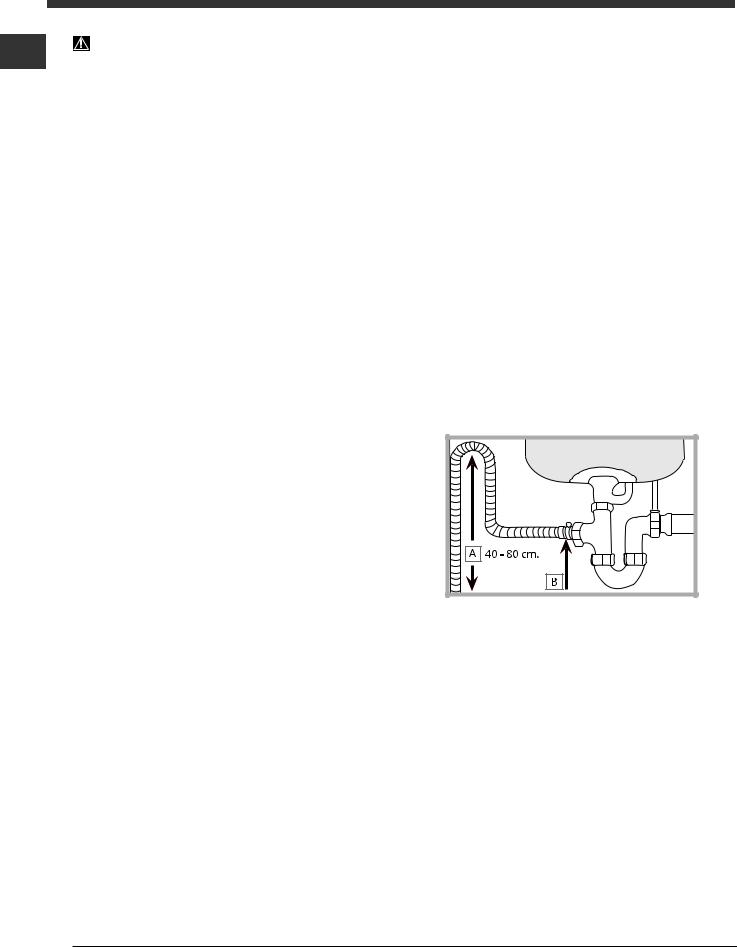
Installazione
È importante conservare questo libretto per poterlo
16consultare in ogni momento. In caso di vendita, di cessione o di trasloco, assicurarsi che resti insieme all’apparecchio.
 Leggere attentamente le istruzioni: ci sono importanti informazioni sull’installazione, sull’uso
Leggere attentamente le istruzioni: ci sono importanti informazioni sull’installazione, sull’uso
e sulla sicurezza.
 In caso di trasloco tenere l’apparecchio in posizione verticale; se fosse necessario, inclinarlo sul lato posteriore.
In caso di trasloco tenere l’apparecchio in posizione verticale; se fosse necessario, inclinarlo sul lato posteriore.
 Questo apparecchio è progettato per l'uso domestico o per applicazioni simili, ad esempio:
Questo apparecchio è progettato per l'uso domestico o per applicazioni simili, ad esempio:
-aree adibite a cucina per il personale in negozi, uffici ed altri ambienti di lavoro;
-case coloniche;
-utilizzo da parte di clienti in hotel, motel ed altri ambienti di tipo residenziale;
-bed and breakfast.
Posizionamento e livellamento
1.Disimballare l’apparecchio e controllare che non abbia subìto danni durante il trasporto.
Se fosse danneggiato non collegarlo e contattare il rivenditore.
2.Sistemare la lavastoviglie facendo aderire i fianchi o lo schienale ai mobili adiacenti o alla parete. L’apparecchio può anche essere incassato sotto a un
piano di lavoro continuo* (vedi foglio di Montaggio).
3.Posizionare la lavastoviglie su un pavimento piano e rigido. Compensare le irregolarità svitando o avvitando i piedini anteriori finché l’apparecchio non sia orizzontale. Un accurato livellamento dà stabilità ed evita vibrazioni, rumori e spostamenti.
4.Per regolare l’altezza del piedino posteriore, agire sulla boccola esagonale di colore rosso presente nella parte inferiore, frontale, centrale della lavastoviglie, con una chiave a bocca esagonale apertura 8 mm., girando in senso orario per aumentare l’altezza e in senso antiorario per diminuirla. (vedere foglio istruzioni
incasso allegato alla documentazione)
Collegamenti idraulici ed elettrici
 L’adattamento degli impianti elettrici e idraulici per l’installazione deve essere eseguito solo
L’adattamento degli impianti elettrici e idraulici per l’installazione deve essere eseguito solo
da personale qualificato.
 La lavastoviglie non deve appoggiare sui tubi o sul cavo di alimentazione elettrica.
La lavastoviglie non deve appoggiare sui tubi o sul cavo di alimentazione elettrica.
 L’apparecchio deve essere collegato alla rete di distribuzione dell’acqua utilizzando tubi nuovi.
L’apparecchio deve essere collegato alla rete di distribuzione dell’acqua utilizzando tubi nuovi.
Non riutilizzare i vecchi tubi.
I tubi di carico e di scarico dell’acqua
e il cavo di alimentazione elettrica possono essere orientati verso destra o sinistra per consentire
la migliore installazione.
Collegamento del tubo di carico dell’acqua
•A una presa d’acqua fredda: avvitare bene il tubo di carico a un rubinetto con bocca filettata da 3/4 gas; prima di avvitare, far scorrere l’acqua finché non sia limpida affinché le eventuali impurità non intasino l’apparecchio.
•A una presa d’acqua calda: nel caso di impianto centralizzato di termosifoni, la lavastoviglie può essere alimentata con acqua calda di rete purché non superi la temperatura di 60°C.
Avvitare il tubo al rubinetto come descritto per la presa d’acqua fredda.
 Se la lunghezza del tubo di carico non è sufficiente, rivolgersi a un negozio specializzato
Se la lunghezza del tubo di carico non è sufficiente, rivolgersi a un negozio specializzato
o a un tecnico autorizzato (vedi Assistenza).
 La pressione dell’acqua deve essere compresa nei valori riportati dalla tabella Dati tecnici (vedi a lato).
La pressione dell’acqua deve essere compresa nei valori riportati dalla tabella Dati tecnici (vedi a lato).
 Fare attenzione che nel tubo non ci siano né pieghe né strozzature.
Fare attenzione che nel tubo non ci siano né pieghe né strozzature.
Collegamento del tubo di scarico dell’acqua collegare il tubo di scarico, senza piegarlo, a una conduttura di scarico con diametro minimo di 4 cm.
Il tubo di scarico deve essere ad un’altezza compresa tra 40 e 80 cm. dal pavimento o piano d’appoggio della lavastoviglie (A).
Prima di collegare il tubo di scarico dell’acqua al sifone del lavandino, rimuovere il tappo di plastica (B).
* Presente solo su alcuni modelli.
2
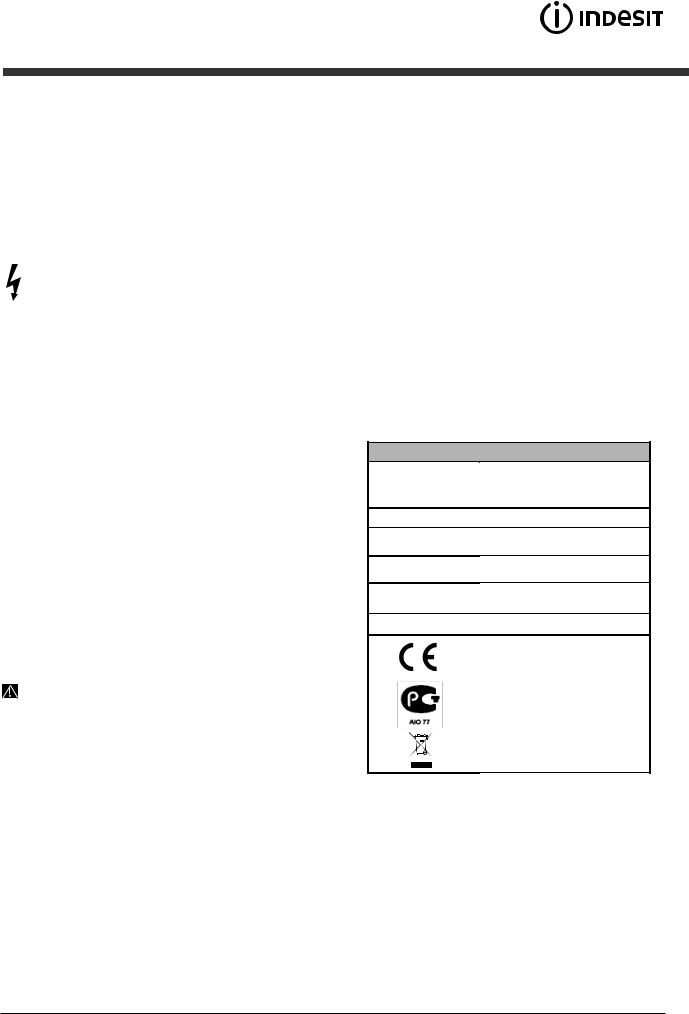
Sicurezza antiallagamento
Per garantire che non si generino allagamenti, la lavastoviglie:
- è dotata di un sistema che interrompe l’ingresso dell’acqua nel caso di anomalie o di perdite dall’interno.
Alcuni modelli sono dotati di un dispositivo supplementare di sicurezza New Acqua Stop*, che garantisce l’antiallagamento anche in caso di rottura del tubo di alimentazione.
ATTENZIONE: TENSIONE PERICOLOSA!
Il tubo di carico dell’acqua, non deve in nessun caso, essere tagliato in quanto contiene parti sotto tensione.
Collegamento elettrico
Prima di inserire la spina nella presa della corrente, accertarsi che:
•la presa abbia la messa a terra e sia a norma di legge;
•la presa sia in grado di sopportare il carico massimo di potenza della macchina, indicato nella targhetta caratteristiche sulla controporta
(vedi capitolo Descrizione della lavastoviglie);
•la tensione di alimentazione sia compresa nei valori indicati nella targhetta caratteristiche sulla controporta;
•la presa sia compatibile con la spina dell’apparecchio. In caso contrario richiedere la sostituzione della spina a un tecnico autorizzato (vedi Assistenza); non usare prolunghe o prese multiple.
 Ad apparecchio installato, il cavo di alimentazione elettrica e la presa della corrente devono essere facilmente raggiungibili.
Ad apparecchio installato, il cavo di alimentazione elettrica e la presa della corrente devono essere facilmente raggiungibili.
Il cavo non deve subire piegature o compressioni.
 Se il cavo di alimentazione è danneggiato, deve essere sostituito dal costruttore o dal suo Servizio di Assistenza Tecnica, in modo da prevenire ogni rischio. (Vedi Assistenza)
Se il cavo di alimentazione è danneggiato, deve essere sostituito dal costruttore o dal suo Servizio di Assistenza Tecnica, in modo da prevenire ogni rischio. (Vedi Assistenza)
 L’Azienda declina ogni responsabilità qualora queste norme non vengano rispettate.
L’Azienda declina ogni responsabilità qualora queste norme non vengano rispettate.
Striscia anticondensa* |
16 |
|
Dopo aver incassato la lavastoviglie aprire la porta e |
||
|
||
incollare la striscia adesiva trasparente sotto al ripiano in |
|
|
legno per proteggerlo dalla eventuale condensa. |
|
Avvertenze per il primo lavaggio
Dopo l’installazione, immediatamente prima del primo lavaggio, riempire completamente d’acqua il serbatoio del sale e solo dopo aggiungere circa 1 Kg di sale (vedi capitolo Brillantante e sale rigenerante): è normale che l’acqua trabocchi. Selezionare il grado di durezza dell’acqua (vedi Tabella Durezza, capitolo Brillantante e sale rigenerante). Dopo il caricamento del sale la spia MANCANZA SALE* si spegne.
 Il mancato riempimento del contenitore del sale, può provocare il danneggiamento del dolcificatore dell’acqua e dell’elemento riscaldante.
Il mancato riempimento del contenitore del sale, può provocare il danneggiamento del dolcificatore dell’acqua e dell’elemento riscaldante.
Dati Tecnici |
|
|
Dimensioni |
Larghezza cm. 45 |
|
Altezza cm. 85 |
||
|
Profondità cm. 60 |
|
Capacità |
10 coperti standard |
|
Pressione acqua |
0,05 ÷ 1MPa (0.5 ÷ 10 bar) |
|
alimentazione |
7,25 – 145 psi |
|
Tensione di |
vedi targhetta caratteristiche |
|
alimentazione |
||
|
||
Potenza totale |
vedi targhetta caratteristiche |
|
assorbita |
||
|
||
Fusibile |
vedi targhetta caratteristiche |
|
|
Questa apparecchiatura è |
|
|
conforme alle seguenti |
|
|
Direttive Comunitarie: |
|
|
-2006/95/EC (Bassa Tensione) |
|
|
-2004/108/EC (Compatibilità |
|
|
Elettromagnetica) |
|
|
-2005/32/EC (Comm. Reg. |
|
|
1275/2008) (Ecodesign) |
|
|
-97/17/EC (Etichettatura) |
|
|
-2002/96/EC (Smaltimento) |
* Presente solo su alcuni modelli.
3

Descrizione dell’apparecchio
Vista d’insieme
16
1. Cestello superiore
2. Irroratore superiore
3. Ribaltine
4. Regolatore altezza cestello
5. Cestello inferiore
6. Irroratore inferiore
7. Cestello posate
8. Filtro lavaggio
9. Serbatoio sale
10. Vaschette detersivo e serbatoio brillantante
11. Targhetta caratteristiche
12. Pannello comandi***
Pannello comandi
|
Tasto e Spia |
|
|
|
Mezzo Carico* |
|
|
|
Tasto e Spia |
Spia Avvio/Pausa |
|
|
Avvio Ritardato* |
||
|
|
||
|
Manopola |
Tasto |
|
|
Avvio/Pausa |
||
Selezione Programma |
|||
|
|||
|
|
Spia |
|
|
|
Mancanza |
|
|
|
Brillantante* |
|
|
Spia Lavaggio |
Spia |
|
Tasto e spia* |
Mancanza Sale* |
||
e Avvio |
|||
On-Off/Reset |
Ritardato 3h.* |
|
|
|
|
||
|
Spia Asciugatura e |
Spia Fine programma |
|
|
Avvio Ritardato 6h.* |
e Avvio Ritardato 9h.* |
|
*** Solo sui modelli ad incasso totale * Presente solo su alcuni modelli.
Il numero e il tipo di programmi ed opzioni variano in base al modello di lavastoviglie.
4
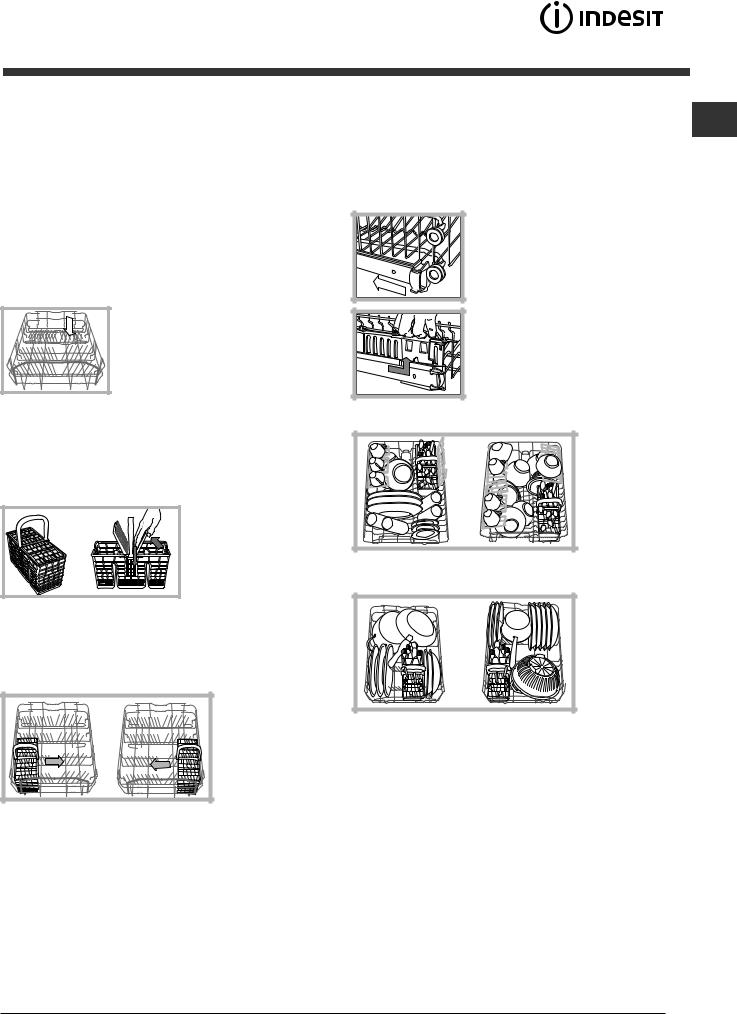
Caricare i cestelli
 Prima di caricare i cesti, eliminare dalle stoviglie i residui di cibo e vuotare bicchieri e coppe dei liquidi rimasti.
Prima di caricare i cesti, eliminare dalle stoviglie i residui di cibo e vuotare bicchieri e coppe dei liquidi rimasti.
Sistemare le stoviglie in modo che siano ben ferme e non si ribaltino.
Dopo aver caricato, controllare che gli irroratori ruotino liberamente.
Cesto inferiore
Il cesto inferiore può contenere pentole, coperchi, piatti, insalatiere, posate ecc..secondo gli Esempi di caricamento. Piatti e coperchi grandi vanno sistemati di preferenza ai lati del cesto, facendo attenzione a non bloccare la rotazione dell’irroratore superiore.
Alcuni modelli di lavastoviglie, dispongono di settori
reclinabili*, gli stessi si possono usare in posizione verticale
per la sistemazione dei piatti oppure in posizione orizzontale
per sistemare pentole e insalatiere.
Cestino delle posate
Il cestino delle posate deve essere posizionato frontalmente sul cesto inferiore, facendolo scorrere tra gli inserti fissi, o sul cesto superiore, soluzione indicata quando si esegue un lavaggio a mezzo carico (sui mod. provvisti di tale opzione).
- E’ munito di ribaltine scorrevoli che consento-
no una sistemazione ottimale delle posate.
 I coltelli e gli utensili con punte taglienti devono essere sistemati nel cestino delle posate con le punte rivolte verso il basso o sistemati sulle ribaltine del cesto superiore in posizione orizzontale.
I coltelli e gli utensili con punte taglienti devono essere sistemati nel cestino delle posate con le punte rivolte verso il basso o sistemati sulle ribaltine del cesto superiore in posizione orizzontale.
Esempi di posizionamento dei cestini posate
Cesto superiore
Caricarvi le stoviglie delicate e leggere: bicchieri, tazze da tè e caffè, piattini, insalatiere basse, padelle, pentole basse poco sporche, secondo gli Esempi di caricamento.
•Tazze e tazzine, coltelli lunghi e acuminati, posate di servizio: posizionarli sulle ribaltine**.
Regolare l’altezza del cesto superiore
Per agevolare la sistemazione delle stoviglie, è possibile |
16 |
|
|
sistemare il cesto superiore in posizione alta o bassa. |
|
 E’ preferibile regolare l’altezza del cesto superiore a CESTO VUOTO.
E’ preferibile regolare l’altezza del cesto superiore a CESTO VUOTO.
Non sollevare o abbassare MAI il cesto su un solo lato.
Aprire i fermi delle guide del cesto a destra e a sinistra ed estrarre il cesto; sistemarlo in alto o in basso, farlo scivolare lungo le guide fino a far entrare anche le rotelle anteriori e chiudere i fermi (vedi figura).
Se il cesto è dotato di maniglie Dual Space* (vedi figura), estrarre il cesto superiore a fine corsa, impugnare le maniglie ai lati del cesto e muovere verso l’alto o verso il basso; lasciare ricadere il cesto accompagnandolo.
Esempi di caricamento cesto superiore
Esempi di caricamento cesto inferiore
Stoviglie non adatte al lavaggio in lavastoviglie
•Oggetti di legno, con impugnatura in legno o in corno o con parti incollate.
•Oggetti di alluminio, rame, ottone, peltro o stagno.
•Stoviglie di plastica non termoresistente.
•Porcellane antiche o dipinte a mano.
•Argenteria antica. L’argenteria non antica può invece essere lavata con un programma delicato e accertandosi che non sia a contatto con altri metalli.
 Si consiglia l’utilizzo di stoviglie idonee al lavaggio in lavastoviglie.
Si consiglia l’utilizzo di stoviglie idonee al lavaggio in lavastoviglie.
* Presente solo in alcuni modelli. ** Variabili per numero e posizione.
5
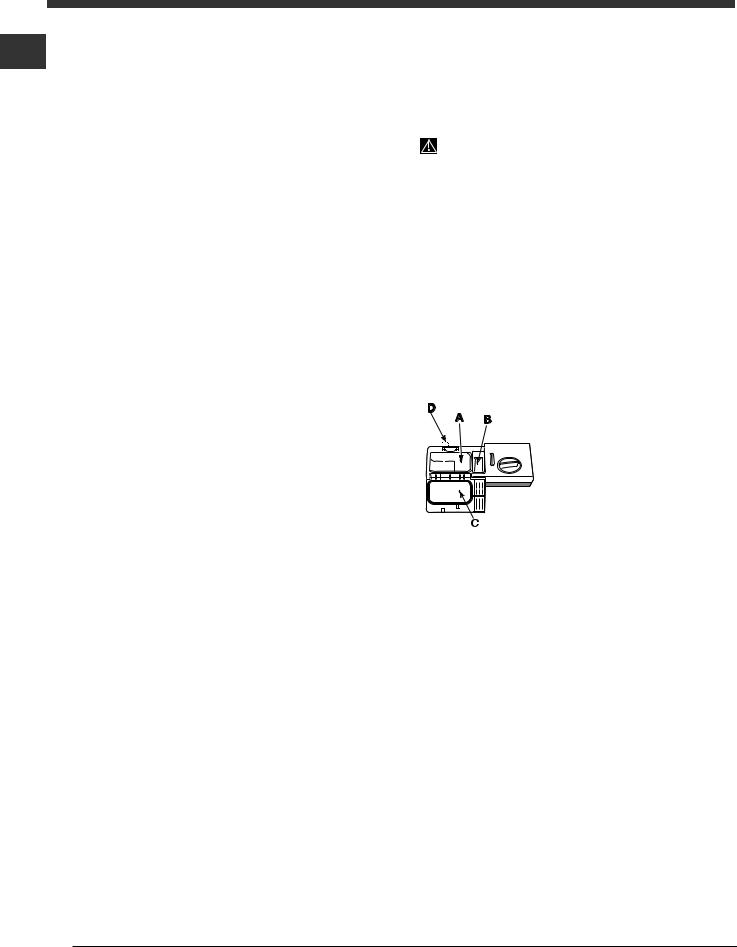
Avvio e utilizzo
Avviare la lavastoviglie
16
1.Aprire il rubinetto dell’acqua.
2.Premere il tasto ON-OFF: tutte le spie presenti sul pannello comandi si illuminano per alcuni secondi.
3.Aprire la porta e dosare il detersivo (vedi sotto).
4.Caricare i cestelli (vedi Caricare i cestelli) e chiudere la porta.
5.Selezionare il programma ruotando la manopola SELEZIONE PROGRAMMA in senso orario: far coincidere la tacca sulla manopola con il numero o il simbolo del programma. La spia relativa al tasto AVVIO/ PAUSA pulsa.
6.Selezionare le opzioni di lavaggio* (vedi a lato).
7.Avviare premendo il tasto AVVIO, la spia smette di pulsare e diventa a luce fissa. L’accensione della spia relativa al lavaggio avvisa dell’inizio del programma.
8.Alla fine del programma si illumina la spia FINE (luce fissa). Spegnere l’apparecchio premendo il tasto ONOFF, chiudere il rubinetto dell’acqua e staccare la spina dalla presa di corrente.
9.Aspettare alcuni minuti prima di togliere le stoviglie, per evitare di scottarsi. Scaricare i cestelli iniziando da quello inferiore.
 - Per ridurre il consumo di energia elettrica, in alcune condizioni di NON utilizzo, la macchina si spegne automaticamente.
- Per ridurre il consumo di energia elettrica, in alcune condizioni di NON utilizzo, la macchina si spegne automaticamente.
Modificare un programma in corso
Se si è selezionato un programma sbagliato è possibile modificarlo, purché appena iniziato: a lavaggio avviato, per cambiare ciclo di lavaggio spegnere la macchina con una pressione prolungata del tasto ON/OFF/Reset, riaccenderla con lo stesso tasto e selezionare nuovamente programma e opzioni desiderati.
Aggiungere altre stoviglie
Premere il tasto Avvio/Pausa, (la luce del tasto pulsa) Aprire la porta facendo attenzione alla fuoriuscita di vapore e inserire le stoviglie. Premere il tasto Avvio/ Pausa (luce fissa): il ciclo riprende.
 Premendo il tasto Avvio/Pausa per mettere in pausa la macchina, si interrompe sia il programma sia l’Avvio Ritardato se impostato.
Premendo il tasto Avvio/Pausa per mettere in pausa la macchina, si interrompe sia il programma sia l’Avvio Ritardato se impostato.
In questa fase non si può cambiare il programma.
Interruzioni accidentali
Se durante il lavaggio si apre la porta o si verifica un’interruzione di corrente, il programma si interrompe. Riprende dal punto in cui si era interrotto quando si chiude la porta o torna la luce.
Caricare il detersivo
Il buon risultato del lavaggio dipende anche dal corretto dosaggio del detersivo, eccedendo non si lava in modo più efficace e si inquina l’ambiente.
Utilizzare solo detersivo per lavastoviglie.
 NON UTILIZZARE detergenti per lavaggio a mano.
NON UTILIZZARE detergenti per lavaggio a mano.
 Un utilizzo eccessivo di detersivo può lasciare residui di schiuma a fine ciclo.
Un utilizzo eccessivo di detersivo può lasciare residui di schiuma a fine ciclo.
 L’utilizzo delle pastiglie è consigliato solo nei modelli dove è presente l’opzione PASTIGLIE MULTIFUNZIONE.
L’utilizzo delle pastiglie è consigliato solo nei modelli dove è presente l’opzione PASTIGLIE MULTIFUNZIONE.
 Le migliori prestazioni di lavaggio ed asciugatura, si ottengono solo con l’utilizzo di detersivo in polvere, brillantante liquido e sale.
Le migliori prestazioni di lavaggio ed asciugatura, si ottengono solo con l’utilizzo di detersivo in polvere, brillantante liquido e sale.
vaschetta A: Detersivo per lavaggio vaschetta B: Detersivo per prelavaggio
1. Aprire il coperchio C premendo il pulsante D.
2. Dosare il detersivo
consultando la Tabella dei
programmi:
• in polvere: vaschette A e B. • pastiglie: quando il
programma ne richiede 1, metterla nella vaschetta A e
chiudere il coperchio; quando ne richiede 2, mettere la seconda sul fondo della vasca.
3. Eliminare i residui di detersivo dai bordi della vaschetta e chiudere il coperchio fino allo scatto.
* Presente solo su alcuni modelli.
6

Opzioni di lavaggio*
Le OPZIONI possono essere impostate, modificate o azzerate solo dopo aver scelto il programma di lavaggio e prima di aver premuto il tasto Avvio/Pausa.
Possono essere selezionate solo le opzioni compatibili al tipo di programma scelto. Se un’opzione non è compatibile con il programma selezionato, (vedi tabella programmi) il led relativo lampeggia velocemente 3 volte.
Se viene selezionata un’opzione incompatibile con un’opzione o un programma di lavaggio precedentemente impostati, l’opzione non compatibile lampeggia 3 volte e si spegne, mentre rimane accesa l’ultima impostazione scelta.
 Per deselezionare un’opzione erroneamente impostata, premere di nuovo sul tasto corrispondente.
Per deselezionare un’opzione erroneamente impostata, premere di nuovo sul tasto corrispondente.
Avvio ritardato*
È possibile posticipare di 3, 6 o 9 ore l’avvio del programma: 1:Dopo aver selezionato il programma di lavaggio desiderato ed altre eventuali opzioni, premere il tasto AVVIO RITARDATO: la spia si illumina.
2: Selezionare l’avvio desiderato premendo in successione il tasto dell’Avvio ritardato, le spie del lavaggio (3 ore), asciugatura (6 ore) e fine (9 ore) si illumineranno in successione.
Con un’ulteriore pressione del tasto Avvio Ritardato, si deseleziona l’opzione e la spia si spegne.
3. A selezione avvenuta, premendo il tasto Avvio/Pausa avrà inizio il conto alla rovescia, il ritardo selezionato lampeggia ed il tasto Avvio/Pausa smette di pulsare (luce fissa).
3. A tempo scaduto la spia dell’AVVIO RITARDATO si spegne, e il programma si avvia.
 Non è possibile impostare l’Avvio Ritardato a ciclo avviato.
Non è possibile impostare l’Avvio Ritardato a ciclo avviato.
Mezzo carico*
16
Se le stoviglie sono poche, si può effettuare il mezzo carico risparmiando acqua, energia e detersivo. Selezionare il programma, premere il tasto MEZZO CARICO: la spia si illumina.
Un’ulteriore pressione del tasto MEZZO CARICO deseleziona l’opzione.
 Ricordarsi di dimezzare la quantità di detersivo.
Ricordarsi di dimezzare la quantità di detersivo.
 E’ preferibile utilizzare detersivo in polvere.
E’ preferibile utilizzare detersivo in polvere.
 Questa opzione non è disponibile con il programma: Rapido.
Questa opzione non è disponibile con il programma: Rapido.
(Opzioni DSG 263)
Tabella Opzioni |
A |
B |
Avvio |
Mezzo |
|
|
Ritardato |
Carico |
Intensivo |
Si |
Si |
|
|
|
Normale |
Si |
Si |
|
|
|
Quotidiano |
Si |
Si |
|
|
|
Ammollo |
Si |
Si |
|
|
|
Eco |
Si |
Si |
|
|
|
Rapido |
Si |
No |
|
|
|
* Presente solo su alcuni modelli.
7

Programmi
Se le stoviglie sono poco sporche o sono state sciacquate precedentemente sotto l’acqua, ridurre
16sensibilmente la dose del detersivo.
 Il numero e il tipo di programmi ed opzioni variano in base al modello di lavastoviglie.
Il numero e il tipo di programmi ed opzioni variano in base al modello di lavastoviglie.
Indicazioni per la |
|
|
Detersivo |
|
|
|
Durata del |
|
Programma |
(A) = vaschetta A |
Asciugatura |
Opzioni |
programma |
||||
scelta dei |
(B) = vaschetta B |
(tolleranza |
||||||
programmi |
|
polvere |
liquido |
pastiglie |
|
|
±10%) |
|
|
|
|
|
Hrs. Min. |
||||
|
|
|
|
|
|
|
||
Stoviglie e pentole molto |
|
|
|
|
|
|
|
|
sporche (da non usare per |
|
25 g (A) |
25 ml (A) |
1 (A) |
Si |
A-B |
2:25’ |
|
pezzi delicati). |
Intensivo |
|||||||
|
|
|
|
|
|
|||
|
|
|
|
|
|
|
||
|
|
|
|
|
|
|
|
|
Stoviglie e pentole |
|
|
|
|
|
|
|
|
normalmente sporche. |
|
21 g (A) |
21 ml (A) |
1 (A) |
Si |
A-B |
1:50’ |
|
Programma standard |
|
|||||||
Normale |
4 g (B) |
4 ml (B) |
||||||
giornaliero. |
|
|
|
|
||||
|
|
|
|
|
|
|||
|
|
|
|
|
|
|
|
|
Sporco quotidiano in |
|
|
|
|
|
|
|
|
quantità limitata. (4 coperti |
|
25 g (A) |
25 ml (A) |
1 (A) |
No |
A-B |
1:00’ |
|
+ 1 pentola + 1 padella). |
Quotidiano |
|||||||
|
|
|
|
|
|
|||
|
|
|
|
|
|
|
||
|
|
|
|
|
|
|
|
|
Lavaggio preliminare in |
|
|
|
|
|
|
|
|
attesa di completare |
|
No |
No |
No |
No |
A-B |
0:08’ |
|
il carico al pasto |
Ammollo |
|||||||
successivo. |
|
|
|
|
|
|
||
|
|
|
|
|
|
|
|
|
Lavaggio ecologico a bassi |
|
|
|
|
|
|
|
|
consumi energetici, adatto |
Eco* |
25 g (A) |
25 ml (A) |
1 (A) |
Si |
A-B |
2:50’ |
|
a stoviglie e pentole. |
||||||||
|
|
|
|
|
|
|||
|
|
|
|
|
|
|
|
|
Ciclo economico e veloce |
|
|
|
|
|
|
|
|
da utilizzare per stoviglie |
|
|
|
|
|
|
|
|
poco sporche, subito dopo |
|
21 g (A) |
21 ml (A) |
1 (A) |
No |
A |
0:35’ |
|
l'uso. (2 piatti +2 bicchieri |
|
|||||||
+4 posate+1 pentola + 1 |
|
|
|
|
|
|
|
|
padellino) |
Rapido |
|
|
|
|
|
|
|
|
|
|
|
|
|
|
|
|
Note:
le migliori prestazioni dei programmi “Quotidiano e Rapido”, si ottengono preferibilmente rispettando il numero di coperti specificati.
* Il programma Eco, rispetta la norma EN-50242, dura più a lungo rispetto ad altri programmi ma presenta un minor consumo di energia ed in più è rispettoso con l’ambiente.
Nota per i laboratori di Prove: per informazioni sulle condizioni della prova comparativa EN, farne richiesta all’indirizzo: ASSISTENZA_EN_LVS@indesitcompany.com
Per facilitare il dosaggio del detersivo è bene sapere che:
1 cucchiaio da cucina = 15 gr. di polvere = 15 ml di liquido circa - 1 cucchiaino da cucina = 5 gr. di polvere = 5 ml di liquido circa
8
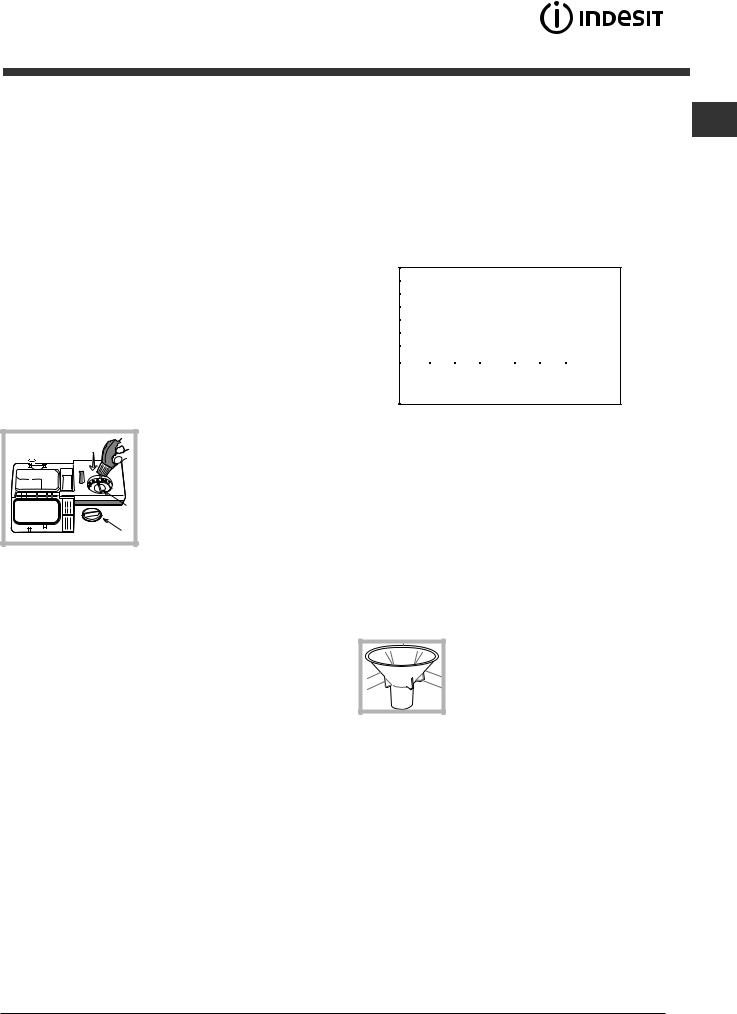
Brillantante e sale rigenerante
 Usare solo prodotti specifici per lavastoviglie. Non usare sale alimentare o industriale nè detersivi per il lavaggio a mano.
Usare solo prodotti specifici per lavastoviglie. Non usare sale alimentare o industriale nè detersivi per il lavaggio a mano.
Seguire le indicazioni riportate sulla confezione.
 Se si usa un prodotto multifunzione, non è necessario aggiungere brillantante, si consiglia invece di aggiungere sale, specie se l’acqua è dura o molto dura. Seguire le indicazioni riportate sulla confezione.
Se si usa un prodotto multifunzione, non è necessario aggiungere brillantante, si consiglia invece di aggiungere sale, specie se l’acqua è dura o molto dura. Seguire le indicazioni riportate sulla confezione.
 Non aggiungendo né sale né brillantante è normale che le spie MANCANZA SALE* e MANCANZA BRILLANTANTE* rimangano accese.
Non aggiungendo né sale né brillantante è normale che le spie MANCANZA SALE* e MANCANZA BRILLANTANTE* rimangano accese.
Caricare il brillantante
Il brillantante facilita l’asciugatura delle stoviglie facendo scivolare l’acqua dalla superficie, così che non rimangano striature o macchie.
Il serbatoio del brillantante va riempito:
• quando sul pannello si accende la spia MANCANZA
BRILLANTANTE*; |
F |
G |
1.Aprire il serbatoio ruotando il tappo (G) in senso antiorario.
2.Versare il brillantante evitando che fuoriesca. Se accade, pulire subito con un panno asciutto.
3.Riavvitare il tappo.
Non versare MAI il brillantante direttamente all’interno della vasca.
Regolare la dose di brillantante
Se non si è soddisfatti del risultato dell’asciugatura, è possibile regolare la dose di brillantante. Con un cacciavite girare il regolatore (F) scegliendo tra 6 posizioni (la regolazione di fabbrica è sul 4):
•se sulle stoviglie ci sono striature, girare verso i numeri bassi (1-3).
•se ci sono gocce d’acqua o macchie di calcare girare verso i numeri alti (4-6).
Impostazione durezza dell’acqua
Ogni lavastoviglie è corredata di un dolcificatore dell’acqua che, utilizzando del sale rigenerante specifico per lavastoviglie, fornisce acqua priva di calcare per il lavaggio delle stoviglie.
Questa lavastoviglie, consente una regolazione che riduce l’inquinamento ed ottimizza le prestazioni di lavaggio in funzione della durezza dell’acqua. Il dato è reperibile presso l’Ente erogatore dell’acqua potabile.
- Spegnere la macchina con il tasto ON/OFF e aprire la porta.
-Posizionare la manopola SELEZIONE PROGRAMMA prima sul 5° programma ed in succesione sul 1° programma e nuovamente sul 5°.
-Premere il tasto ON/OFF, le spie delle fasi ciclo lampeggiano; ora è possibile selezionare il livello di durezza.
Ad ogni programma corrisponde un livello di durezza:
Es: 1° programma, livello durezza 1 16 2° programma, livello durezza 2 ecc..ecc... fino ad un
massimo di 5* livelli.
(Il decalcificatore è impostato dalla fabbrica sul livello 3). - Per uscire dalla funzione attendere alcuni secondi o premere un tasto delle opzioni* o spegnere la macchina con il tasto ON/OFF.
Se si utilizzano le pastiglie multifunzione, riempire comunque il serbatoio del sale.
Tabella Durezze Acqua
°dH |
|
|
°fH |
mmol/l |
livello |
||
0 |
|
6 |
0 |
10 |
0 |
1 |
1 |
6 |
|
11 |
11 |
20 |
1,1 |
2 |
2 |
12 |
|
17 |
21 |
30 |
2,1 |
3 |
3 |
17 |
|
34 |
31 |
60 |
3,1 |
6 |
4 |
34 |
|
50 |
61 |
90 |
6,1 |
9 |
5* |
Da 0°f a 10°f si consiglia di non utilizzare sale.
* con questa impostazione la durata dei cicli può lievemente prolungarsi.
(°dH = durezza in gradi tedeschi - °fH = durezza in gradi francesi - mmol/l = millimol/litro)
Caricare il sale rigenerante
Per avere buoni risultati di lavaggio è indispensabile verificare che il serbatoio del sale non sia mai vuoto. Il sale rigenerante elimina il calcare dall’acqua, evitando che si depositi sulle stoviglie. Il serbatoio del sale è posto nella parte inferiore della lavastoviglie (vedi Descrizione) e va riempito:
•quando il galleggiante verde* non è visibile osservando il tappo del sale;
•quando sul pannello si accende la spia MANCANZA SALE*;
1.Estrarre il cesto inferiore e svitare il tappo del serbatoio in senso antiorario.
2.Solo per il primo utilizzo: riempire il serbatoio di acqua fino al bordo.
3.Posizionare l’imbuto* (vedi figura) e
riempire il serbatoio di sale fino al bordo (circa 1 kg); è normale che trabocchi un po’ d’acqua.
4. Togliere l’imbuto*, eliminare i residui di sale dall’imbocco; sciacquare il tappo sotto l’acqua corrente prima di avvitarlo, disponendolo a testa in giù e facendo defluire l’acqua dalle quattro fessure disposte a stella nella parte inferiore del tappo. (tappo con galleggiante verde*)
E’ consigliabile effettuare questa operazione ad ogni caricamento del sale.
Chiudere bene il tappo, affinché nel serbatoio non entri detersivo durante il lavaggio (potrebbe danneggiarsi irrimediabilmente il dolcificatore).
 Quando si rende necessario, caricare il sale prima di un ciclo di lavaggio in modo da eliminare la soluzione salina traboccata dal contenitore del sale.
Quando si rende necessario, caricare il sale prima di un ciclo di lavaggio in modo da eliminare la soluzione salina traboccata dal contenitore del sale.
* Presente solo su alcuni modelli.
9
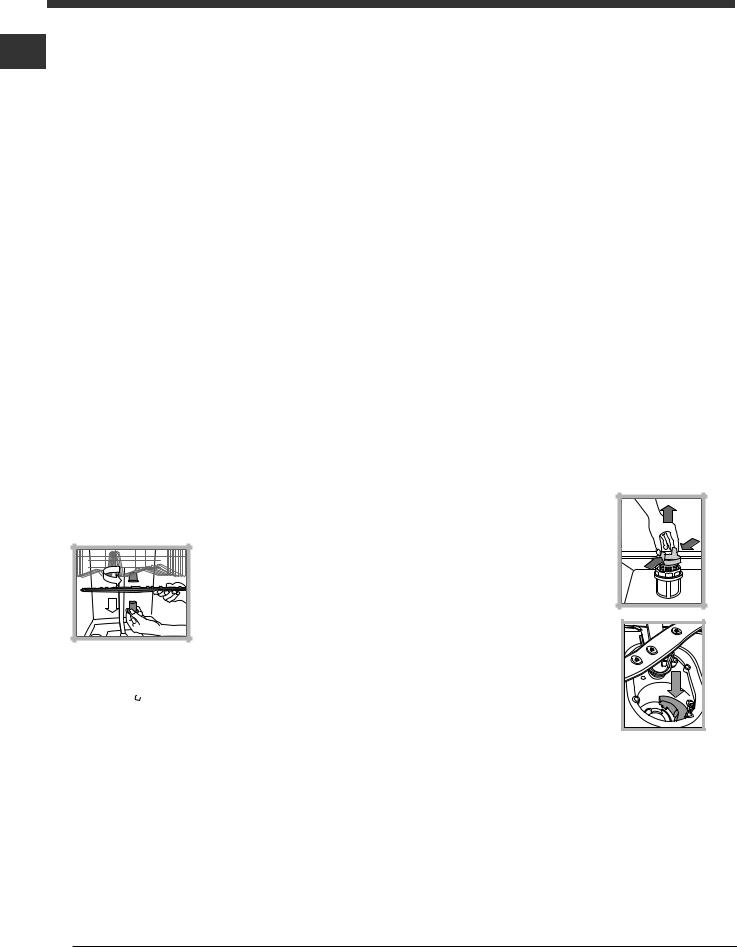
Manutenzione e cura
|
Escludere acqua e corrente elettrica |
|
16 |
• |
Chiudere il rubinetto dell’acqua dopo ogni lavaggio |
|
||
|
|
per eliminare il pericolo di perdite. |
|
• |
Staccare la spina dalla presa di corrente quando si |
|
|
pulisce la macchina e durante i lavori di |
|
|
manutenzione. |
|
Pulire la lavastoviglie |
|
|
• |
La superficie esterna e il pannello di controllo |
|
|
possono essere puliti con un panno inumidito con |
|
|
acqua non abrasivo. Non usare solventi |
|
|
o abrasivi. |
|
• |
La vasca interna può essere pulita da eventuali |
|
|
macchie con un panno imbevuto di acqua e poco |
|
|
aceto. |
|
Evitare i cattivi odori |
|
|
• |
Lasciare sempre socchiusa la porta per evitare il |
|
|
ristagno di umidità. |
|
• |
Pulire regolarmente le guarnizioni perimetrali di |
|
|
tenuta della porta e delle vaschette detersivo con |
|
|
una spugnetta umida. Si eviteranno così ristagni di |
|
|
cibo, principali responsabili del cattivo odore. |
|
Pulire gli irroratori |
|
|
Può succedere che residui di cibo si attacchino agli |
|
|
irroratori e ostruiscano i fori da cui esce l’acqua: di |
|
|
tanto in tanto è bene controllarli e pulirli con uno |
|
|
spazzolino non metallico. |
|
|
I due irroratori, sono entrambi smontabili. |
|
|
|
Per smontare l’irroratore |
|
|
superiore, occorre svitare |
|
|
girando in senso antiorario la |
|
|
ghiera di plastica.L’irroratore |
|
|
superiore, va rimontato con la |
|
|
parte con il maggior numero |
|
|
di fori rivolta verso l’alto. |
|
|
L’irroratore inferiore si smonta |
|
|
tirandolo verso l’alto. |
Pulizia del filtro entrata acqua* Se i tubi dell’acqua sono nuovi o sono rimasti per lungo tempo inattivi, prima di fare l’allacciamento, far scorrere l’acqua fino a che diventi limpida e sia priva di impurità. Senza questa precauzione, c’è il rischio che il punto dove entra l’acqua si intasi, danneggiando la lavastoviglie.
 Periodicamente, pulire il filtro entrata acqua posizionato all’uscita del rubinetto.
Periodicamente, pulire il filtro entrata acqua posizionato all’uscita del rubinetto.
-Chiudere il rubinetto dell’acqua.
-Svitare l’estremità del tubo di carico acqua, togliere il filtro e pulirlo delicatamente sotto un getto di acqua corrente.
-Inserire nuovamente il filtro e avvitare il tubo.
Pulire i filtri
Il gruppo filtrante è formato da tre filtri che puliscono l’acqua di lavaggio dai residui di cibo e la rimettono in circolo: per avere buoni risultati di lavaggio è necessario pulirli.
 Pulire i filtri con regolarità.
Pulire i filtri con regolarità.
 La lavastoviglie non deve essere usata senza filtri o con filtro sganciato.
La lavastoviglie non deve essere usata senza filtri o con filtro sganciato.
• Dopo alcuni lavaggi, controllare il gruppo filtrante e se necessario pulirlo accuratamente sotto acqua corrente, aiutandosi con uno spazzolino non metallico, seguendo le istruzioni sotto riportate:
1.ruotare in senso antiorario il filtro cilindrico C ed estrarlo (fig. 1).
2.Estrarre il bicchiere filtro B facendo una leggera pressione sulle alette laterali (Fig. 2);
3.Sfilare il piatto filtro inox A. (fig. 3).
4.Ispezionare il pozzetto ed eliminare eventuali residui di cibo. NON RIMUOVERE MAI la protezione della pompa di
lavaggio (particolare di colore nero) (fig.4).
+ |
|
! |
B |
+ |
" |
Dopo la pulizia dei filtri, rimontare il gruppo filtrante e ricollocarlo correttamente nella sua sede; è fondamentale per un buon funzionamento della lavastoviglie.
Se ci si assenta per lunghi periodi
•Staccare i collegamenti elettrici e chiudere il rubinetto dell’acqua.
•Lasciare socchiusa la porta.
•Al rientro, fare un lavaggio a vuoto.
* Presente solo su alcuni modelli.
10

Precauzioni e consigli
 L’apparecchio è stato progettato e costruito in conformità alle norme internazionali di sicurezza. Queste avvertenze sono fornite per ragioni di sicurezza e devono essere lette attentamente.
L’apparecchio è stato progettato e costruito in conformità alle norme internazionali di sicurezza. Queste avvertenze sono fornite per ragioni di sicurezza e devono essere lette attentamente.
Sicurezza generale
•Questo elettrodomestico non può venire usato da persone (bambini compresi) con ridotte capacità fisiche, sensoriali o mentali, o mancanza di esperienza e conoscenza, a meno che non venga loro fornita supervisione o istruzioni riguardanti l'uso da una persona responsabile della loro sicurezza.
•È necessaria la supervisione di un adulto per evitare che i bambini giochino con l'elettrodomestico.
•L’apparecchio è stato concepito per un uso di tipo non professionale all’interno dell’abitazione.
•L’apparecchio deve essere usato per il lavaggio delle stoviglie a uso domestico, solo da persone adulte e secondo le istruzioni riportate in questo libretto.
•L’apparecchio non va installato all’aperto, nemmeno se lo spazio è riparato, perché è molto pericoloso lasciarlo esposto a pioggia e temporali.
•Non toccare la lavastoviglie a piedi nudi.
•Non staccare la spina dalla presa della corrente tirando il cavo, bensì afferrando la spina.
•È necessario chiudere il rubinetto dell’acqua e staccare la spina dalla presa della corrente prima di effettuare operazioni di pulizia e manutenzione.
•In caso di guasto, in nessun caso accedere ai meccanismi interni per tentare una riparazione.
•Non toccare mai la resistenza.
•Non appoggiarsi o sedersi sulla porta aperta: l’apparecchio potrebbe ribaltarsi.
•La porta non deve essere tenuta nella posizione aperta perchè può rappresentare il pericolo di inciampare.
•Tenere il detersivo e il brillantante fuori dalla portata dei bambini.
•Gli imballaggi non sono giocattoli per bambini.
Risparmiare e rispettare l’ambiente
16
Risparmiare acqua ed energia
•Avviare la lavastoviglie solo a pieno carico. In attesa che la macchina sia piena, prevenire i cattivi odori con il ciclo Ammollo (vedi Programmi).
•Selezionare un programma adatto al tipo di stoviglie e al grado di sporco consultando la Tabella dei programmi:
-per stoviglie normalmente sporche utilizzare il programma Eco, che garantisce bassi consumi energetici e di acqua.
-se il carico è ridotto attivare l’opzione Mezzo carico*
(vedi Avvio e utilizzo).
•Se il proprio contratto di erogazione dell’energia elettrica prevede fasce orarie di risparmio energetico, effettuare i lavaggi negli orari a tariffa ridotta. L’opzione Avvio ritardato* (vedi Avvio e utilizzo) può aiutare a organizzare i lavaggi in tal senso.
Detersivi senza fosfati, senza cloro e contenenti enzimi
•Si consiglia vivamente di usare i detersivi senza fosfati e senza cloro che sono i più indicati per la tutela dell’ambiente.
•Gli enzimi sviluppano un’azione particolarmente efficace con temperature prossime ai 50°C, per cui con i detersivi con enzimi si possono impostare lavaggi a basse temperature e ottenere gli stessi risultati che si avrebbero a 65°C.
•Dosare bene il detersivo in base alle indicazioni del produttore, alla durezza dell’acqua, al grado di sporco e alla quantità di stoviglie per evitare sprechi. Pur biodegradabili, i detersivi contengono elementi che alterano l’equilibrio della natura.
Smaltimento
•Smaltimento del materiale di imballaggio: attenersi alle norme locali, così gli imballaggi potranno essere riutilizzati.
•La direttiva Europea 2002/96/CE sui rifiuti di apparecchiature elettriche ed elettroniche (RAEE), prevede che gli elettrodomestici non debbano essere smaltiti nel normale flusso dei rifiuti solidi urbani. Gli apparecchi dismessi devono essere raccolti separatamente per ottimizzare il tasso di recupero e riciclaggio dei materiali che li compongono e impedire potenziali danni per la salute e l’ambiente. Il simbolo del cestino barrato è riportato su tutti i prodotti per ricordare gli obblighi di raccolta separata.
Per ulteriori informazioni, sulla corretta dismissione degli elettrodomestici, i detentori potranno rivolgersi al servizio pubblico preposto o ai rivenditori.
* Presente solo su alcuni modelli.
11

Anomalie e rimedi
Può accadere che l’apparecchio non funzioni. Prima di telefonare all’Assistenza controllare che non si tratti
16di un problema facilmente risolvibile aiutandosi con il seguente elenco.
Qualora il problema persista chiamare il Servizio Assistenza Tecnico Autorizzato: Numero Unico Nazionale 199.199.199 (costo massimo al minuto per chiamate da rete fissa Euro 0,1426).
Anomalie: |
Possibili cause / Soluzione: |
||
|
|
||
La lavastoviglie non parte o non |
• Spegnere la macc hina con il tasto ON/OFF, riaccendere dopo un minuto |
||
risponde ai comandi |
|
circa e reimpostare il programma. |
|
|
• La spina non è ben inserita nella presa di corrente. |
||
|
• La porta della lavastoviglie non è ben chiusa. |
||
|
|
|
|
La porta non si chiude |
• |
La serratura è scattata; spingere energicamente la porta fino a sentire il |
|
|
“clack”. |
||
|
|
||
|
|
||
La lavastoviglie non scarica |
• Il programma non è ancora terminato. |
||
acqua. |
• |
Il tubo di scarico dell’acqua è piegato (vedi Installazione). |
|
• Lo scarico del lavello è ostruito. |
|||
|
|||
|
• Il filtro è intasato da residui di cibo. |
||
|
|
|
|
La lavastoviglie fa rumore. |
• |
Le stoviglie sbattono tra loro o contro gli irroratori. |
|
|
• |
Eccessiva presenza di schiuma: il detersivo non è dosato |
|
|
|
adeguatamente o non è idoneo al lavaggio in lavastoviglie . (vedi Avvio e |
|
|
|
utilizzo). |
|
|
|
||
Su stoviglie e bicchieri ci sono |
• Manca il sale rigenerante o la sua regolazione non è adegu ata alla |
||
depositi calcarei o una patina |
|
durezza dell’acqua (vedi Brillantante e s ale). |
|
• |
Il tappo del serbatoio del s ale non è chiuso bene. |
||
biancastra. |
|||
• Il brillantante è es aurito o il dosaggio è insufficiente. |
|||
|
|||
|
|
|
|
Su stoviglie e bicchieri ci sono |
• |
Il dosaggio del brillantante è eccessivo. |
|
striature o sfumature bluastre. |
|
|
|
|
|
||
Le stoviglie sono poco |
• È stato selezionato un programma senza asciugatura. |
||
asciutte. |
• |
Il brillantante è es aurito o il dosaggio è insufficiente (vedi Brillantante e |
|
|
sale). |
||
|
|
||
|
• La regolazione del brillantante non è adeguata. |
||
|
• Le stoviglie sono in materiale antiaderente o in plastica. |
||
|
|
||
Le stoviglie non sono pulite. |
• I cestelli sono troppo carichi (vedi Caricare i cestelli). |
||
|
• Le stoviglie non son o sistemate bene. |
||
|
• Gli irroratori non sono liberi di ruotare. |
||
|
• Il programma di lavaggio è troppo blando (vedi Programmi). |
||
|
• |
Eccessiva presenza di schiuma: il detersivo non è dosato |
|
|
|
adeguatamente o non è idoneo al lavaggio in lavastoviglie . (vedi Avvio e |
|
|
|
utilizzo). |
|
|
• Il tappo del brilla ntante non è stato chiuso correttamente. |
||
|
• Il filtro è sporco o intasato (vedi Manutenzione e cura). |
||
|
• Manca il sale rigenerante (vedi Brillantante e sale). |
||
|
|
||
La lavastoviglie non carica |
• Manca l’acqua nella rete idrica. |
||
acqua – Allarme rubinetto |
• Il tubo di carico dell’acqua è piegato (vedi Installazione) . |
||
chiuso. |
• Aprire il rubinetto e l’apparecchio si avvia dopo pochi m inuti. |
||
(si sentono dei brevi bip)* |
• L’apparecchio si è bloccato perché non si è intervenuti al suono dei bip*. |
||
(lampeggiano velocemente le spie |
|
Spegnere la macc hina con il tasto ON/OFF, aprire il rubinetto e dopo 20 |
|
Asciugatura e Fine). |
|
secondi riaccendere premendo lo stesso tasto. Riprogrammare la |
|
|
|
macchina e riavviare. |
|
|
|
|
|
Allarme al tubo di carico |
• |
Spegnere la macc hina premendo il tasto ON/OFF. Chiudere il rubinetto |
|
dell’acqua/Filtrino entrata |
|
dell’acqua per evitare allagamenti, staccare la spina della corrente. |
|
acqua intasato. |
|
Controllare che il filtro entrata acqua non sia intasato da impurità. |
|
(lampeggiano velocemente le spie: |
|
(vedere capitolo "Manutenzione e Cura") |
|
Lavaggio, Asciugatura e Fine) |
|
|
|
|
|
|
|
* Presente solo su alcuni modelli.
12

Operating instructions
DISHWASHER
EN
English,13
Contents
Installation, 14-15
Positioning and levelling
Connecting the water and electricity supplies Advice regarding the first wash cycle Technical data
DSG 263
DSG 051
Description of the appliance, 16
Overall view Control panel
Loading the racks, 17
Lower rack
Cutlery basket
Upper rack
Start-up and use, 18-19
Starting the dishwasher
Measuring out the detergent
Wash options
Wash cycles, 20
Table of wash cycles
Rinse aid and refined salt, 21
Measuring out the rinse aid
Measuring out the refined salt
Care and maintenance, 22
Shutting off the water and electricity supplies Cleaning the dishwasher
Preventing unpleasant odours Cleaning the sprayer arms Cleaning the water inlet filter Cleaning the filters
Leaving the machine unused for extended periods
Precautions and advice, 23
General safety Disposal
Saving energy and respecting the environment
Troubleshooting, 24
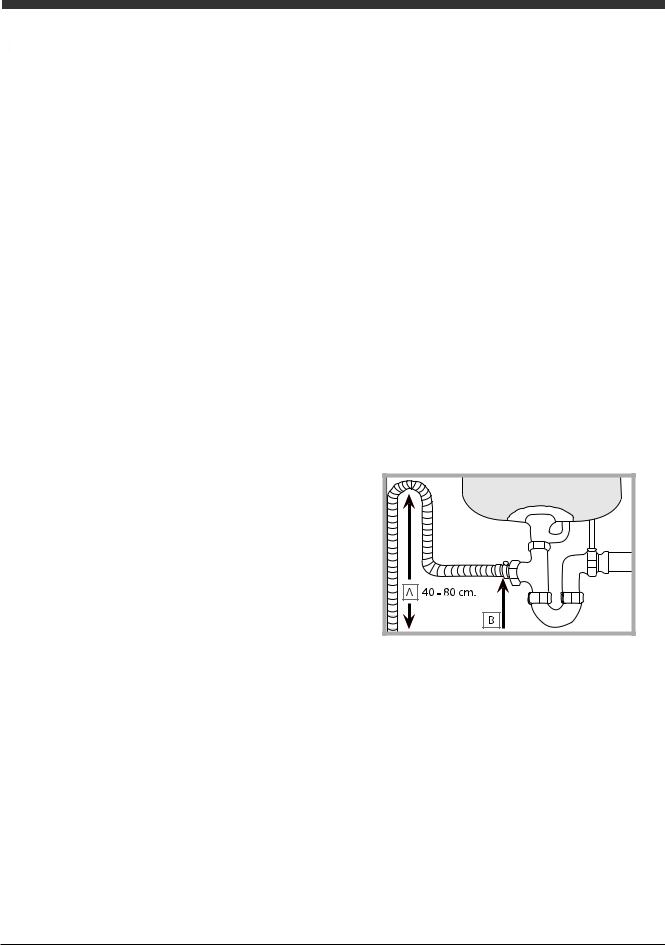
Installation
EN |
|
|
Keep this instruction manual in a safe place for |
|
future reference. If the appliance is sold, given away or |
||||
|
||||
|
moved, please ensure the manual is kept with the |
|||
|
machine, so that the new owner may benefit from the |
|||
|
advice contained within it. |
|||
 Please read this instruction manual carefully: it contains important information regarding the safe installation, use and maintenance of the appliance.
Please read this instruction manual carefully: it contains important information regarding the safe installation, use and maintenance of the appliance.
 If the appliance must be moved at any time, keep it in an upright position; if absolutely necessary, it may be tilted onto its back.
If the appliance must be moved at any time, keep it in an upright position; if absolutely necessary, it may be tilted onto its back.
 This appliance is intended to be used in household and similar applications such as:
This appliance is intended to be used in household and similar applications such as:
-staff kitchen areas in shops, offices and other working environments;
-farm houses;
-by clients in hotels, motels and other residential type environments;
-bed and breakfast type environments.
Positioning and levelling
1.Remove the appliance from all packaging and check that it has not been damaged during transportation.
If it has been damaged, contact the retailer and do not proceed any further with the installation process.
2.Check the dishwasher by placing it so that its sides or back panel are in contact with the adjacent cabinets or
even with the wall. This appliance can also be recessed under a single worktop* (see the Assembly instruction sheet).
3.Position the dishwasher on a level and sturdy floor. If the floor is uneven, the front feet of the appliance may be adjusted until it reaches a horizontal position. If the appliance is levelled correctly, it will be more stable and much less likely to move or cause vibrations and noise while it is operating.
4.Adjust the height of the rear foot from the front of the appliance* on the central lower part of the dishwasher, turning
a hexagonal spanner (red color) with an opening of 8 mm in a clockwise direction to increase the height or in an anticlockwise direction to decrease the height.
Connecting the water and electricity supplies
 Connection to the water and electricity supplies should only be performed by a qualified technician.
Connection to the water and electricity supplies should only be performed by a qualified technician.
 The dishwasher should not stand on top of the water hoses or the electricity supply cable.
The dishwasher should not stand on top of the water hoses or the electricity supply cable.
 The appliance must be connected to the water supply network using new hoses.
The appliance must be connected to the water supply network using new hoses.
Do not use old hoses.
The water inlet and outlet hoses and the electricity supply cable may be positioned towards the right or the left in order to achieve the best possible installation.
Connecting the water inlet hose
•To a suitable cold water connection point: before attaching the hose, run the water until it is perfectly clear so that any impurities that may be present in the water do not clog the appliance; after performing this operation, screw the inlet hose tightly onto a tap with a ¾ gas threaded connection.
•To a suitable hot water connection point: your dishwasher may be supplied with hot water from the mains supply (if you have a central heating system with radiators) provided that it does not exceed a temperature of 60°C.
Screw the hose to the tap as described for connection to a cold water supply.
 If the inlet hose is not long enough, contact a specialist store or an authorised technician (see Assistance).
If the inlet hose is not long enough, contact a specialist store or an authorised technician (see Assistance).
 The water pressure must be within the values indicated in the Technical data table (see adjacent information).
The water pressure must be within the values indicated in the Technical data table (see adjacent information).
 The hose should not be bent or compressed.
The hose should not be bent or compressed.
Connecting the water outlet hose
Connect the outlet hose (without bending it) to a drain duct with a minimum diameter of 4 cm.
The outlet hose must be at a height ranging from 40 to 80 cm from the floor / surface where the dishwasher rests (A).
Before connecting the water outlet hose to the sink drain, remove the plastic plug (B).
* Only available in selected models.
14

Anti-flooding protection
To ensure floods do not occur, the dishwasher:
- is provided with a special system which blocks the water supply in the event of anomalies or leaks from inside the appliance.
Some models are also equipped with the supplementary safety device New Acqua Stop*, which guarantees antiflooding protection even in the event of a supply hose rupture.
WARNING: HAZARDOUS VOLTAGE!
Under no circumstance should the water inlet hose be cut as it contains live electrical parts.
Electrical connection
Before inserting the plug into the electrical socket, make sure that:
•The socket is earthed and complies with current regulations.
•The socket can withstand the maximum load of the appliance, which is indicated on the data plate located on the inside of the door (see chapter entitled Description of the appliance).
•The power supply voltage falls within the values indicated on the data plate on the inside of the door.
•The socket is compatible with the plug of the appliance. If this is not the case, ask an authorised technician to replace the plug (see Assistance); do not use extension cables or multiple sockets.
 Once the appliance has been installed, the power supply cable and the electrical socket should be easily accessible.
Once the appliance has been installed, the power supply cable and the electrical socket should be easily accessible.
 The cable should not be bent or compressed.
The cable should not be bent or compressed.
 If the power supply cable is damaged, it must be replaced by the manufacturer or its Technical Assistance Service in order to prevent all potential hazards. (See Assistance)
If the power supply cable is damaged, it must be replaced by the manufacturer or its Technical Assistance Service in order to prevent all potential hazards. (See Assistance)
 The Company shall not be held responsible for any incidents that occur if these regulations are not observed.
The Company shall not be held responsible for any incidents that occur if these regulations are not observed.
Anti-condensation strip* |
EN |
|
After installing the dishwasher, open the door and stick |
||
|
||
the adhesive transparent strip under the wooden shelf in |
|
|
order to protect it from any condensation which may |
|
|
form. |
|
|
Advice regarding the first wash cycle |
|
|
After the appliance has been installed, immediately |
|
|
before running the first wash cycle, completely fill the |
|
|
salt dispenser with water and add only then |
|
|
approximately 1 kg of salt (see chapter entitled Rinse aid |
|
|
and refined salt). The water may overflow: this is normal |
|
|
and is not a cause for concern. Select the water |
|
|
hardness value (see chapter entitled Rinse aid and |
|
|
refined salt). - After the salt has been poured into the |
|
|
machine, the LOW SALT indicator light* switches off. |
|
|
If the salt container is not filled, the water softener |
|
|
and the heating element may be damaged as a result. |
|
Technical data
Dimensions |
width 45 cm |
|
height 85 cm |
||
|
depth 60 cm |
|
Capacity |
10 standard place-settings |
|
|
|
|
Water supply |
0,05 ÷ 1MPa (0.5 ÷ 10 bar) |
|
pressure |
7,25 psi – 145 psi |
|
|
|
|
Power supply |
See appliance data plate |
|
voltage |
||
|
||
|
|
|
Total absorbed |
See appliance data plate |
|
power |
|
|
Fuse |
See appliance data plate |
|
|
This dishwasher conforms to the |
|
|
following European Community |
|
|
Directives: |
|
|
-2006/95/EC (Low Voltage) |
|
|
-2004/108/EC (Electromagnetic |
|
|
Compatibility) |
|
|
-2005/32/EC (Comm. Reg. |
|
|
1275/2008) (Ecodesign) |
|
|
-97/17/EC (Labelling) |
|
|
-2002/96/ CE Waste Electrical |
|
|
and Electronic Equipment |
|
|
(WEEE) |
* Only available in selected models.
15

Description of the appliance
Overall view
EN
1. Upper rack
2. Upper sprayer arm
3. Tip-up compartments
4. Rack height adjuster
5. Lower rack
6. Lower sprayer arm
7. Cutlery basket
8. Washing filter
9. Salt dispenser
10. Detergent and rinse aid dispensers
11. Data plate
12. Control Panel***
Control panel
Delayed start |
|
|
|
|
|
||
button and |
|
|
Half load |
||||
|
|
||||||
indicator light* |
|
|
|||||
|
|
button and |
|||||
|
|
|
|
|
|||
|
|
|
|
|
indicator light* |
||
Select wash |
|
|
|
|
|
|
|
cycle knob |
|
|
|
|
|
Start/Pause button |
|
|
|
|
|
||||
|
|
|
|
|
|
|
|
|
|
|
|
|
|
|
and indicator light* |
|
|
|
|
|
|
|
|
|
|
|
|
|
|
|
|
|
|
|
|
|
|
|
|
|
Washing and 3h. |
|
|
|
|
|
|
|
Low Salt |
|
|
|
|
|
|
|
|
||
|
|
|
|
|
|
|
|
||
|
|
|
|
|
|
|
|
||
ON/OFF/RESET |
|
|
|
|
|
|
|
indicator light* |
|
Delayed start |
|
|
|
|
|
|
|
||
button and |
|
|
|
|
|
|
|
|
|
indicator light* |
|
|
|
|
|
Low Rinse aid |
|||
indicator light* |
|
|
|
|
|
||||
|
|||||||||
|
|
|
|
|
|
indicator light* |
|||
|
Drying and |
|
|
|
|||||
|
|
|
End and 9h. |
||||||
|
6h.Delayed start |
|
|
Delayed start |
|||||
|
indicator light* |
|
|
indicator light* |
|||||
|
|
||||||||
|
|
|
|||||||
***Only in completely built-in models.
*
The number and type of wash cycles and options may vary depending on the dishwasher model.
16

Loading the racks
 Before loading the racks, remove all food residues from the crockery and empty liquids from glasses and cups. Arrange the crockery so that it is held in place firmly and does not tip over.
Before loading the racks, remove all food residues from the crockery and empty liquids from glasses and cups. Arrange the crockery so that it is held in place firmly and does not tip over.
After loading the appliance, check that the sprayer arms can rotate freely.
Lower rack
The lower rack can hold pans, lids, plates, salad bowls, cutlery, etc. as seen in the Loading examples.
Plates and large covers should be placed at the sides of the rack, ensuring that they do not block the rotation of the upper sprayer arm.
Some dishwasher models are fitted with tip-up sections*, which can be used in a vertical position when arranging plates or in a horizontal position when arranging pans and salad bowls.
Cutlery basket
The type of cutlery basket may vary according to the dishwasher model: The cutlery basket should be positioned at the front of the lower rack, by sliding it between the fixed inserts, or on the upper rack when the half load option has been selected (in models featuring this option).
- It has a collapsible sliding system which means the cutlery can be arranged in the best possible way.
 Knives and other utensils with sharp edges must be placed in the cutlery basket with the points facing downwards, or they must be positioned horizontally in the tip-up compartments on the upper rack.
Knives and other utensils with sharp edges must be placed in the cutlery basket with the points facing downwards, or they must be positioned horizontally in the tip-up compartments on the upper rack.
Cutlery basket positioning examples
ù |
Upper rack
Load this rack with delicate and lightweight crockery: glasses, tea and coffee cups, saucers, small salad bowls, saucepans and small saucepans which are not too soiled, using the
Loading examples as a guide.
• Mugs and cups, long sharp knives and serving utensils: place these on the tip-up compartments**.
Adjusting the height of the upper rack
In order to make it easier to arrange the crockery, the upper |
EN |
|
|
rack may be moved to a higher or lower level. |
|
 The height of the upper rack should ideally be adjusted WHEN THE RACK IS EMPTY.
The height of the upper rack should ideally be adjusted WHEN THE RACK IS EMPTY.
Never lift or lower the rack on one side only.
Open the left and right guide rail stops and pull out the rack; position it higher or lower as required, slide it along the guide rails until the front wheels are in place and close the stops (see figure).
If the rack is fitted with “Dual Space” handles* (see figure), pull out the upper rack until it reaches its stop point, grip the handles at the sides of the rack and move it upwards or downwards, then slowly let it fall back into place.
Loading examples for the upper rack
Loading examples for the lower rack
Items which should not be washed in the dishwasher
•Wooden items, objects with wooden or horn handles or glued-on parts.
•Items made from aluminium, copper, brass, pewter or tin.
•Items made from plastic material which is not heat-resistant.
•Antique or hand-painted porcelain.
•Antique silver. Silver which is not antique may, however, be washed in the dishwasher using a delicate wash cycle, provided that it does not come into contact with other metals.
 We recommend the use of crockery which is dishwasher safe.
We recommend the use of crockery which is dishwasher safe.
*Only available in selected models. ** The number and position may vary.
17

Start-up and use
Starting the dishwasher
EN
1.Turn the water tap on.
2.Press the ON/OFF button: all the indicator lights on the control panel will light up for a few seconds.
3.Open the door and pour in a suitable amount of detergent (see below).
4.Load the racks (see Loading the racks) and shut the door.
5.Select the wash cycle by turning the WASH CYCLE SELECT knob in a clockwise direction: align the notch on the knob with the number or symbol representing the desired wash cycle. The START/PAUSE indicator light will flash.
6.Select the wash options* (see adjacent
information).
7.Start the cycle by pressing the START button; the indicator light will light up and remain lit in a fixed manner. The indicator light corresponding to the wash phase will switch on, signalling that the wash cycle has begun.
8.At the end of the wash cycle the END indicator light will switch on (fixed light). Switch off the appliance by pressing the ON/OFF button, shut off the water valve and unplug the appliance from the electricity socket.
9.Wait for a few minutes before removing the crockery, in order to avoid burns. Unload the racks, beginning with the lower level.
 - The machine will switch off automatically during certain periods of inactivity, in order to minimise electricity consumption.
- The machine will switch off automatically during certain periods of inactivity, in order to minimise electricity consumption.
Modifying a wash cycle in progress
If a mistake was made during the wash cycle selection process it is possible to change the cycle, provided that it has only just begun: once the wash cycle has started, switch off the machine by pressing and holding the ON/ OFF/Reset button. Switch it back on using the same button and select the desired wash cycle and options.
Adding extra crockery
Press the Start/Pause button (the corresponding indicator light will flash). Open the door, taking care to avoid the escaping steam, and place the crockery inside the appliance. Press the Start/Pause button (fixed light): the cycle starts from the point at which it was interrupted.
 If the Start/Pause button is pressed so as to pause the machine, the wash cycle or the Delayed Start* function (if selected) is interrupted.
If the Start/Pause button is pressed so as to pause the machine, the wash cycle or the Delayed Start* function (if selected) is interrupted.
At this stage it is not possible to change the wash cycle.
Accidental interruptions
If the door is opened during the wash cycle, or if there is a power cut, the cycle stops. It starts again from the point at which it was interrupted once the door has been shut or once the electricity supply is restored.
Measuring out the detergent
A good wash result also depends on the correct amount of detergent being used; exceeding the stated amount does not result in a more effective wash and increases environmental pollution.
 Only use detergent which has been specifically designed for dishwashers.
Only use detergent which has been specifically designed for dishwashers.
 DO NOT USE washing up liquid.
DO NOT USE washing up liquid.
 Using excessive detergent may result in foam residue remaining in the machine after the cycle has ended.
Using excessive detergent may result in foam residue remaining in the machine after the cycle has ended.
 The use of tablets is only recommended for models which offer the MULTI-FUNCTIONAL TABLETS option.
The use of tablets is only recommended for models which offer the MULTI-FUNCTIONAL TABLETS option.
 To achieve the best results from each washing and drying cycle, powder detergent, rinse aid liquid and salt should be used.
To achieve the best results from each washing and drying cycle, powder detergent, rinse aid liquid and salt should be used.
Compartment A: Washing detergent
Compartment B: Pre-wash detergent
D |
|
1. Open cover C by pressing |
A |
B |
button D. |
|
|
2. Pour in the detergent after |
|
|
consulting the Table of wash |
|
|
cycles: |
|
|
• For powder detergent use |
|
|
compartments A and B. |
C• For detergent in tablet form: when the cycle requires 1 tablet,
place it in compartment A and close the cover; when it requires 2, place the second tablet at the bottom of the appliance.
3. Remove detergent residues from the edges of the compartment and close the cover until it clicks.
* Only available in selected models.
18

Wash options*
The OPTIONS may only be set, modified or reset after the wash cycle has been selected and before the Start/Pause button has been pressed.
Only the options which are compatible with the type of wash cycle set may be selected. If an option is not compatible with the selected was cycle (see Table of wash cycles), the corresponding LED flashes rapidly 3 times.
If an option is selected which is incompatible with another option or wash cycle selected previously, the incompatible option light will flash 3 times and switches off, while the most recently selected setting remains lit.
 To deselect an option which has been set by mistake, press the corresponding button again.
To deselect an option which has been set by mistake, press the corresponding button again.
Delayed start*
It is possible to delay the start time of the wash cycle by
3, 6 or 9 hours.
1:After selecting the desired wash cycle and any other options, press the DELAYED START button. the indicator light will illuminate.
2:Select the desired delay time by pressing the Delayed Start button repeatedly; the wash phase (3 hours), the drying phase (6 hours) and end (9 hours) indicator lights will illuminate in succession.
If the Delayed Start button is pressed again, the option is deselected and the indicator light switches off.
3. The countdown will begin once the Start/Pause button has been pressed. The selected delay period indicator light flashes and the Start/Pause button stops flashing (the light becomes fixed instead).
3. Once this time has elapsed, the DELAYED START indicator light switches off and the wash cycle begins.
 The Delayed Start function cannot be set once a wash cycle has been started.
The Delayed Start function cannot be set once a wash cycle has been started.
Half load*
EN
If there are not many dishes to be washed, a half load cycle may be used in order to save water, electricity and detergent. Select the wash cycle and press the HALF LOAD button: the indicator light will illuminate.
 Remember to halve the amount of detergent.
Remember to halve the amount of detergent.
 It is better to use powder detergent in this case.
It is better to use powder detergent in this case.
 This option is incompatible with the following wash cycle: Rapide wash.
This option is incompatible with the following wash cycle: Rapide wash.
(Options DSG 263)
Table of |
A |
B |
|
Delayed |
Half |
||
options |
|||
Start |
Load |
||
|
|||
Intensive |
Yes |
Yes |
|
Normal |
Yes |
Yes |
|
Daily 60’ |
Yes |
Yes |
|
Soak |
Yes |
Yes |
|
Eco |
Yes |
Yes |
|
Rapid |
Yes |
No |
* Only available in selected models.
19
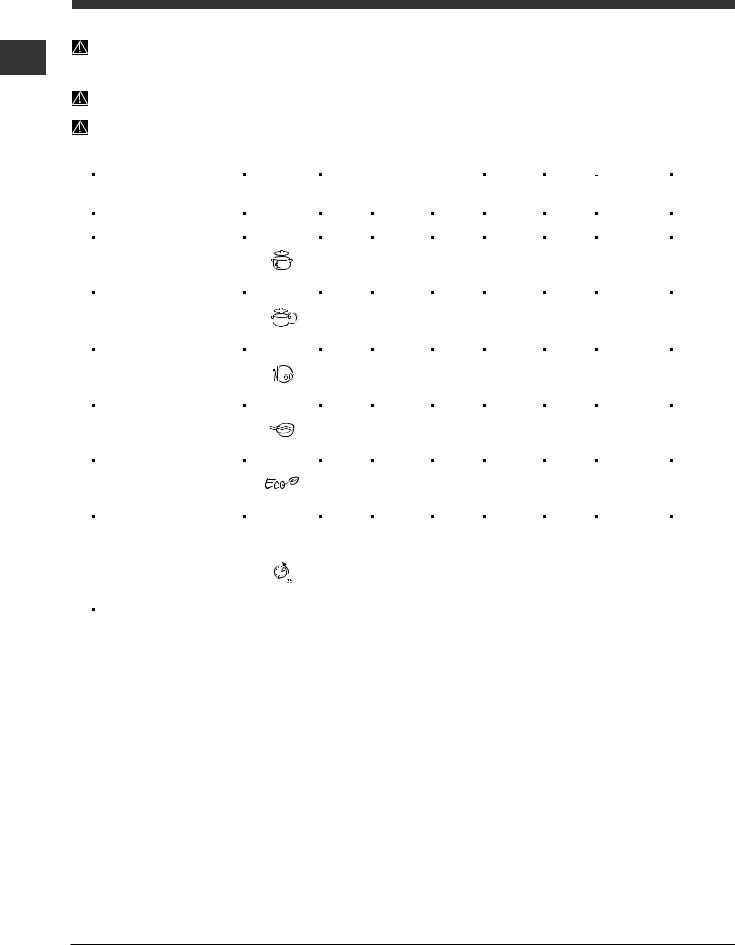
Wash cycles
EN |
If the crockery is only lightly soiled or if it has been rinsed with water before being placed in the |
|
dishwasher, reduce the amount of detergent used accordingly. |
||
|
The number and type of wash cycles and options may vary depending on the dishwasher model.
For available OPTIONS please refer to the Table of options on the Start-up and use page.
|
|
|
Detergent |
|
Wash |
|
Wash cycle |
|
Wash cycle selection |
Wash cycle |
(A) = compartment A |
cycles |
Options |
duration |
|||
(B) = compartment B |
which |
(tolerance |
||||||
instructions |
||||||||
|
|
Powder |
Liquid |
Tablets |
include |
|
±10%) |
|
|
|
drying |
|
Hrs. Min. |
||||
|
|
|
|
|
|
|||
Heavily soiled dishes and |
|
|
|
|
|
|
|
|
pans (not to be used for |
|
25 g (A) |
25 ml (A) |
1 (A) |
Yes |
A-B |
2:25’ |
|
delicate items). |
Intensive |
|||||||
|
|
|
|
|
|
|||
|
|
|
|
|
|
|
||
|
|
|
|
|
|
|
|
|
Normally soiled pans and |
|
21 g (A) |
21 ml (A) |
|
|
|
|
|
dishes. Standard daily wash |
|
1 (A) |
Yes |
A-B |
1:50’ |
|||
|
4 g (B) |
4 ml (B) |
||||||
cycle. |
Normal |
|
|
|||||
|
|
|
|
|
|
|||
|
|
|
|
|
|
|
||
|
|
|
|
|
|
|
|
|
Limited quantity of daily |
|
|
|
|
|
|
|
|
soiling. (4 place settings + 1 |
|
25 g (A) |
25 ml (A) |
1 (A) |
No |
A-B |
1:00’ |
|
saucepan +1 frying pan). |
Daily 60’ |
|
||||||
|
|
|
|
|
|
|||
|
|
|
|
|
|
|
||
|
|
|
|
|
|
|
|
|
Pre-wash for dishes while |
|
|
|
|
|
|
|
|
awaiting completion of the |
|
No |
No |
No |
No |
|
0:08’ |
|
load with the dishes from the |
Soak |
A-B |
||||||
next meal. |
|
|
|
|
|
|
||
|
|
|
|
|
|
|
|
|
Environmentally-friendly wash |
|
|
|
|
|
|
|
|
cycle with low energy |
|
|
|
|
|
|
|
|
consumption levels, suitable |
Eco* |
25 g (A) |
25 ml (A) |
1 (A) |
Yes |
A-B |
2:50’ |
|
for pans and dishes. |
|
|
|
|
|
|
||
|
|
|
|
|
|
|
|
|
Economic and fast wash to |
|
|
|
|
|
|
|
|
be used for lightly soiled |
|
|
|
|
|
|
|
|
dishes. (Run cycle |
|
|
|
|
|
|
|
|
immediately after use) (2 |
|
|
|
|
|
|
|
|
plates + 2 glasses + 4 pieces |
|
21 g (A) |
21 ml (A) |
1 (A) |
No |
A |
0:35’ |
|
of cutlery + 1 saucepan + 1 |
Rapide |
|
|
|
|
|
|
|
small frying pan). |
|
|
|
|
|
|
||
|
|
|
|
|
|
|
|
|
Notes:
Optimum performance levels when using the "Daily 60’ - Rapide wash" cycles can be achieved by observing the maximum amounts of crockery specified.
To make it easier to measure out the detergent, it is worth remembering that:
1 tablespoon = 15 gr. of powder = approximately 15 ml of liquid - 1 teaspoon = 5 gr. of powder = approximately 5 ml of liquid
* The Eco wash cycle adheres to the regulation EN-50242. Although it has a longer duration than other wash cycles it uses less energy and is les harmful to the environment.
Note for Test Laboratories: for information relating to comparative EN testing conditions, please send an email to the following address: ASSISTENZA_EN_LVS@indesitcompany.com
20
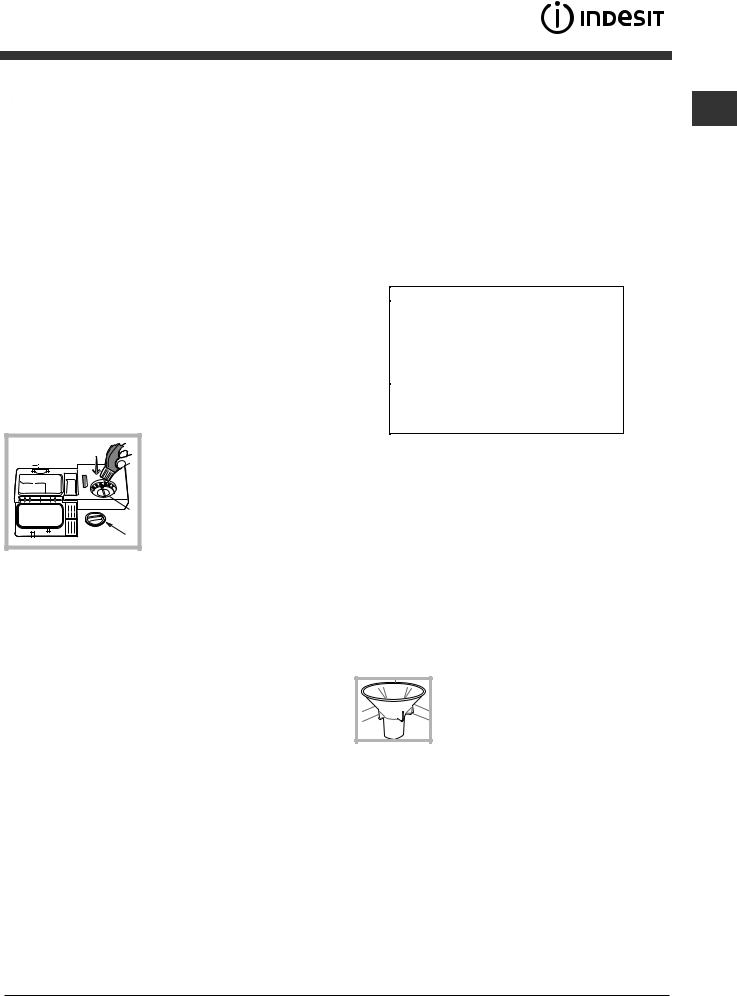
Rinse aid and refined salt
 Only use products which have been specifically designed for dishwashers.
Only use products which have been specifically designed for dishwashers.
Do not use table salt or industrial salt, or washing up liquid.
Follow the instructions given on the packaging.
 If using a multi-functional product it is not necessary to add rinse aid; however, we recommend that you add salt, especially if you live in an area where the water is hard or very hard. Follow the instructions given on the packaging.
If using a multi-functional product it is not necessary to add rinse aid; however, we recommend that you add salt, especially if you live in an area where the water is hard or very hard. Follow the instructions given on the packaging.
 If you do not add salt or rinse aid, the LOW SALT* and LOW RINSE AID* indicator lights remain lit.
If you do not add salt or rinse aid, the LOW SALT* and LOW RINSE AID* indicator lights remain lit.
Measuring out the rinse aid
Rinse aid makes it easier for the crockery to dry, as water runs off surfaces more readily and therefore does not leave streaks or marks.
The rinse aid dispenser should be filled:
• When the LOW RINSE AID* indicator light on the control panel/dislay is illuminated;
1. Open the dispenser by turning the lid (G) in an anticlockwise
direction.
2. Pour in the rinse aid, making

 sure it does not overflow from the
sure it does not overflow from the  F dispenser. If this happens, clean
F dispenser. If this happens, clean
the spill immediately with a dry
Gcloth.
3. Screw the lid back on.
NEVER pour the rinse aid directly into the appliance tub.
Adjusting the amount of rinse aid
If you are not completely satisfied with the drying results, you may adjust the quantity of rinse aid used. Use a screwdriver to turn the dosage adjuster (F) to one of the 6 pre-set positions (the default position is set to 4):
•If there are streaks on the crockery, set the adjustment device to a lower number (1-3).
•If drops of water remain on the crockery or if there are limescale marks present after the cycle has finished, set the adjuster to a higher number (4-6).
Setting the water hardness
Every dishwasher is equipped with a water softener which, by using refined salt designed especially for this type of appliance, supplies water without limescale which is then used to wash the crockery.
This dishwasher offers a setting which helps to reduce pollution and optimises washing performance in accordance with the water hardness level in your area. This information can be obtained from your local water supplier.
-Switch the machine off using the ON/OFF button and open the door.
-Set the SELECT WASH CYCLE knob first to wash cycle 5, then to wash cycle 1, then to wash cycle 5 again.
-Press the ON/OFF button; the wash cycle phase (washing,
drying, end) indicator lights will flash. It is now possible to
select the water hardness level. There is a water hardness EN level for every wash cycle:
E.g.: wash cycle 1, water hardness level 1
wash cycle 2, water hardness level 2, etc. etc., up to a maximum of 5* levels.
(The default water softener setting is level 3).
- To exit the function, wait a few seconds or press one of the option buttons*, or switch off the machine using the ON/OFF button.
Even if using multi-functional tablets, the salt dispenser should still be filled.
Water Hardness Table
°dH |
|
|
°fH |
mmol/l |
level |
||
0 |
|
6 |
0 |
10 |
0 |
1 |
1 |
6 |
|
11 |
11 |
20 |
1.1 |
2 |
2 |
12 |
|
17 |
21 |
30 |
2.1 |
3 |
3 |
17 |
|
34 |
31 |
60 |
3.1 |
6 |
4 |
34 |
|
50 |
61 |
90 |
6.1 |
9 |
5* |
For values between 0°f and 10°f, we do not recommend the use of salt.
* this setting may cause a slight increase in the duration of the cycle.
(°dH = hardness measured in German degrees - °f = hardness measured in French degrees - mmol/l = millimoles per litre)
Measuring out the refined salt
In order to achieve the best possible results using a wash cycle, make sure that the dispenser is never empty. Refined salt removes limescale from the water, thus avoiding the formation of deposits on crockery.
The salt dispenser is located in the lower part of the dishwasher (see Description) and should be filled:
•When the green float* cannot be seen by simply looking at the cap of the salt dispenser.
•When the LOW SALT* indicator light on the control panel/ display is illuminated;
1.Remove the lower rack and unscrew the container cap (anticlockwise).
2.The first time you do this: fill the water tank right up to its edge.
3.Position the funnel* (see figure) and fill
the salt container right up to its edge (this should hold approximately 1 kg); it is not unusual for a little water to leak out.
4. Remove the funnel* and wipe any salt residue away from the opening; rinse the cap under running water and then screw it on, the head facing downwards so as to let the water flow out of the four cracks which are arranged in a star shape on the lower part of the cap. (Salt cap with green float*)
It is advisable to perform this procedure every time you add salt to the container.
Make sure the cap is screwed on tightly, so that no detergent can get into the container during the wash cycle (this could damage the water softener beyond repair).
 When necessary, measure out the salt before a wash cycle so that any saline solution which has leaked out of the salt dispenser is removed.
When necessary, measure out the salt before a wash cycle so that any saline solution which has leaked out of the salt dispenser is removed.
21
* Only available in selected models.

Care and maintenance
EN
|
|
|
|
|
Shutting off the water and electricity |
|
Clean the water inlet filter at the tap outlet regularly. |
||
|
||||
supplies |
- Turn off the water tap. |
|||
• |
Turn off the water tap after every wash cycle to avoid |
- Unscrew the end of the water inlet hose, remove the filter |
||
|
leaks. |
and clean it carefully under running water. |
||
• |
Always unplug the appliance when cleaning it and |
- Replace the filter and screw the water hose back into |
||
position. |
||||
|
when performing maintenance work. |
|||
|
|
|
||
Cleaning the dishwasher |
Cleaning the filters |
|||
|
|
|||
• |
The external surfaces of the machine and the control |
The filter assembly consists of three filters which remove |
||
|
|
|||
|
panel may be cleaned using a non-abrasive cloth |
food residues from the washing water and then recirculate |
||
|
|
|||
|
which has been dampened with water. Do not use |
the water. They should be cleaned if you wish to achieve |
||
|
|
|||
|
solvents or abrasive products. |
the best results in every wash. |
||
|
|
|||
• |
Any marks on the inside of the appliance may be |
|
removed using a cloth dampened with water and a |
|
little vinegar. |
Preventing unpleasant odours |
|
• |
Always keep the door of the appliance ajar in order |
|
to avoid moisture from forming and being trapped |
|
inside the machine. |
• |
Clean the seals around the door and detergent |
|
dispensers regularly using a damp sponge. This will |
|
avoid food becoming trapped in the seals, which is |
|
the main cause behind the formation of unpleasant |
|
odours. |
 Clean the filters regularly.
Clean the filters regularly.
 The dishwasher should not be used without filters, or if the filter is loose.
The dishwasher should not be used without filters, or if the filter is loose.
• After several washes, check the filter assembly and if necessary clean it thoroughly under running water, using a non-metallic brush and following the instructions below:
1.Turn the cylindrical filter C in an anti-clockwise direction and pull it out (fig. 1).
2.Remove the cup filter B by exerting a slight pressure on the side flaps (fig. 2).
3.Slide out the stainless steel plate filter A (fig. 3).
4.Inspect the trap and remove any food residue. NEVER REMOVE the wash cycle pump (black detail) (fig. 4).
Cleaning the sprayer arms |
|
|
Food residue may become encrusted onto the sprayer |
|
|
arms and block the holes used to spray the water. It is |
|
|
therefore recommended that the arms are checked |
|
|
from time to time and cleaned with a small non-metallic |
|
B |
brush. |
|
|
C |
|
|
|
|
|
The two sprayer arms may both be removed. |
|
C |
|
|
|
To remove the upper sprayer |
1 |
2 |
arm, rotate the locking ring |
|
|
in an anti-clockwise |
|
|
direction. |
|
|
The upper sprayer arm |
|
|
should be replaced with the |
A |
|
holes facing upwards. |
|
|
The lower sprayer arm can |
3 |
4 |
|
|
|
be removed by pulling it |
|
|
upwards. |
After cleaning the filters, replace the filter assembly and fix |
|
|
it in position correctly; this is essential for maintaining the |
|
|
efficient operation of the dishwasher. |
|
|
Leaving the machine unused for |
|
|
extended periods |
|
Cleaning the water inlet filter* |
• Disconnect the appliance from the electricity supply and |
|
shut off the water tap. |
|
|
|
|
|
If the water hoses are new or have not been used for an |
• |
Leave the door of the appliance ajar. |
|
extended period of time, let the water run to make sure |
|||
|
|
||
it is clear and free of impurities before performing the |
• |
When you return, run a wash cycle when the dishwasher |
|
|
|||
necessary connections. If this precaution is not taken, |
|
is empty. |
|
|
|
||
the water inlet could become blocked and damage the |
|
|
|
dishwasher. |
|
|
|
|
|
|
22 |
* Only available in selected models. |
|

Precautions and advice
 This appliance was designed and manufactured in compliance with current international safety standards. The following information has been provided for safety reasons and should therefore be read carefully.
This appliance was designed and manufactured in compliance with current international safety standards. The following information has been provided for safety reasons and should therefore be read carefully.
General safety
•This appliance is not intended for use by persons (including children) with reduced physical, sensory or mental capabilities, or lack of experience and knowledge, unless they have been given supervision or instruction concerning use of the appliance by a person responsible for their safety.
•Children should be supervised to ensure that they do not play with the appliance.
•The appliance was designed for domestic use inside the home and is not intended for commercial or industrial use.
•The appliance must be used by adults only, to wash domestic crockery in accordance with the instructions in this manual.
•The appliance must not be installed outdoors, even in covered areas. It is extremely dangerous to leave the machine exposed to rain and storms.
•Do not touch the appliance when barefoot.
•When unplugging the appliance always pull the plug from the mains socket, do not pull on the cable.
•The water supply tap must be shut off and the plug should be removed from the electrical socket before cleaning the appliance or carrying out any maintenance work.
•If the appliance breaks down, do not under any circumstances touch the internal parts in an attempt to perform the repair work yourself.
•Never touch the heating element.
•Do not lean or sit on the open door of the appliance: this may cause the appliance to overturn.
•The door should not be left open as it may create a dangerous obstacle.
•Keep detergent and rinse aid out of reach of children.
•The packaging material should not be used as a toy.
Saving energy and respecting the
environment |
EN |
|
Saving water and energy
•Only begin a wash cycle when the dishwasher is full. While waiting for the dishwasher to be filled, prevent unpleasant odours using the Soak cycle (see Wash cycles).
•Select a wash cycle which is suited to the type of crockery and to the soil level of the crockery using the Table of wash cycles:
-For dishes with a normal soil level, use the Eco wash cycle, which guarantees low energy and water consumption levels.
-If the load is smaller than usual activate the Half load
option* (see Start-up and use).
•If your electricity supply contract gives details of electricity saving time bands, run wash cycles during the periods when a lower tariff is applied. The Delayed start* button (see Start-up and use) helps you organise the wash cycles accordingly.
Phosphate-free and chlorine-free detergents containing enzymes
•We strongly recommend that you use detergents that do not contain phosphates or chlorine, as these products are harmful to the environment.
•Enzymes provide a particularly effective action at temperatures around 50°C, and as a result detergents containing enzymes can be used in conjunction with lowtemperature wash cycles in order to achieve the same results as a normal 65°C wash cycle.
•To avoid wasting detergent, use the product in appropriate quantities based on the manufacturer’s recommendations, the hardness of the water and the soil level and quantity of crockery to be washed. Even if they are biodegradable, detergents contain substances which may alter the balance of nature.
Disposal
•Disposal of packaging materials: observe local legislation so that the packaging may be reused.
•The European Directive 2002/96/EC relating to Waste Electrical and Electronic Equipment (WEEE) states that household appliances should not be disposed of using the normal solid urban waste cycle. Exhausted appliances should be collected separately in order to optimise the cost of re-using and recycling the materials inside the machine, while preventing potential damage to the atmosphere and to public health. The crossed-out dustbin is marked on all products to remind the owner of their obligations regarding separated waste collection.
For further information relating to the correct disposal of household appliances, owners may contact the relevant public authority or the local appliance dealer.
* Only available in selected models.
23

Troubleshooting
Whenever the appliance fails to work, check for a solution from the following list before calling for EN Assistance.
Problem: |
Possible causes / Solutions: |
|
|
|
|
The dishwasher does not start or |
• Switch off the appliance by pressing the ON/OFF button, switch it back on after |
|
cannot be controlled |
approximately one minute and reset the program. |
|
|
• The appliance has not been plugged in properly. |
|
|
• The dishwasher door has not been shut properly. |
|
|
|
|
The door won’t close |
• The lock was released. Strongly push the door until a “clacking” noise is heard. |
|
|
|
|
No water drains out from the |
• The dishwasher cycle has not yet finished. |
|
dishwasher. |
• The water inlet hose is bent (see Installation). |
|
|
• The drain duct is blocked. |
|
|
• The filter is clogged up with food residues. |
|
|
|
|
The dishwasher makes excessive |
• The dishes are rattling against each other or against the sprayer arms. |
|
noise. |
• An excessive amount of foam has been produced: the detergent has not been |
|
|
measured out correctly or it is not suitable for use in dishwashers (see Start-up |
|
|
and use). |
|
|
|
|
The dishes and glasses are |
• The level of the refined salt is low or the dosage setting is not suited to the |
|
covered in a white film or |
hardness of the water (see Rinse aid and salt). |
|
limescale deposits. |
• The lid on the salt dispenser is not closed properly. |
|
|
• The rinse aid has been used up or the dosage is too low. |
|
|
|
|
The dishes and glasses are |
• The rinse aid dosage is too high. |
|
streaked or have a bluish tinge. |
|
|
|
|
|
The crockery has not been dried |
• A wash cycle without a drying program has been selected. |
|
properly. |
• The rinse aid has been used up or the dosage is too low (see Rinse aid and |
|
|
salt). |
|
|
• The rinse aid dispenser setting is not suitable. |
|
|
• The crockery is made from non-stick material or plastic. |
|
|
|
|
The dishes are not clean. |
• The racks are overloaded (see Loading the racks). |
|
|
• The crockery has not been arranged well. |
|
|
• The sprayer arms cannot move freely. |
|
|
• The wash cycle is too gentle (see Wash cycles). |
|
|
• An excessive amount of foam has been produced: the detergent has not been |
|
|
measured out correctly or it is not suitable for use in dishwashers (see Start-up |
|
|
and use). |
|
|
• The lid on the rinse aid compartment has not been shut correctly. |
|
|
• The filter is dirty or blocked (see Care and maintenance). |
|
|
• The refined salt level is low (see Rinse aid and salt). |
|
|
|
|
The dishwasher does not take any |
• There is no water in the mains supply. |
|
water in - Tap shut-off alarm |
• The water inlet hose is bent (see Installation). |
|
(several short beeps are emitted*) |
• Turn on the tap and the appliance will start after a few minutes. |
|
(the Drying and End indicator lights |
• The appliance lock has been activated because no action was taken when the |
|
beeps* sounded. Switch off the appliance using the ON/OFF button, turn on the |
||
flash). |
||
|
tap and switch the appliance back on after 20 seconds by pressing the same |
|
|
button. Re-program the appliance and restart the wash cycle. |
|
|
|
|
Water inlet hose alarm / Water inlet |
• Switch off the appliance by pressing the ON/OFF button. Shut off the water tap |
|
filter blocked |
to eliminate the risk of flooding and remove the plug from the electrical socket. |
|
(the Washing, Drying and End |
Make sure the water inlet filter has not become blocked by impurities (see “Care |
|
indicator lights flashes). |
and maintenance” chapter). |
|
|
|
* Only available in selected models.
24

Mode d’emploi
FR
Français, 25
DSG 263
DSG 051
LAVE-VAISSELLE
Sommaire
.4
Installation, 26-27
Mise en place et mise à niveau Raccordements eau et électricité Conseils pour le premier lavage Caractéristiques techniques
Description de l’appareil, 28
Vue d’ensemble
Tableau de bord
Charger les paniers, 29
Panier inférieur
Panier à couverts
Panier supérieur
Mise en marche et utilisation, 30-31
Mettre en marche le lave-vaisselle
Charger le produit de lavage
Options de lavage
Programmes, 32
Tableau des programmes
Produit de rinçage et sel régénérant, 33
Charger le produit de rinçage Charger le sel régénérant
Entretien et soin, 34
Coupure de l’arrivée d’eau et de courant Nettoyer le lave-vaisselle
Eviter les mauvaises odeurs Nettoyer les bras de lavage Nettoyage du filtre d’entrée d’eau Nettoyer les filtres
En cas d’absence pendant de longues périodes
Précautions et conseils, 35
Sécurité générale
Mise au rebut
Economies et respect de l’environnement
Anomalies et remèdes, 36
25
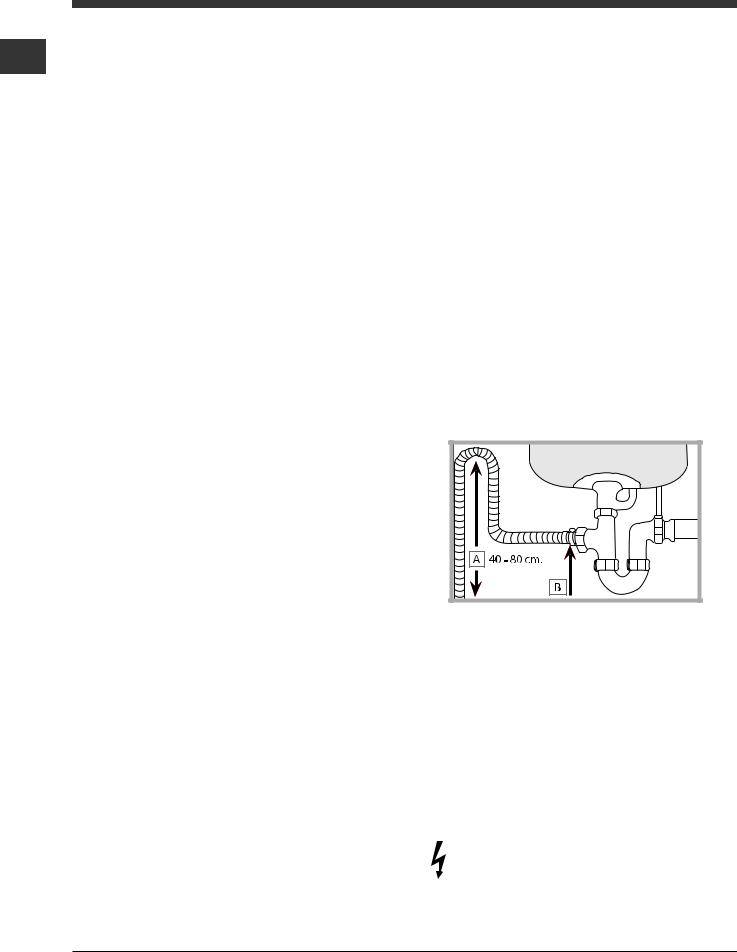
Installation
 Conserver ce mode d’emploi pour pouvoir le consulter à
Conserver ce mode d’emploi pour pouvoir le consulter à
.4 tout moment. En cas de vente, de cession ou de déménagement, s’assurer qu’il accompagne bien l’appareil.
 Lire attentivement les instructions : elles contiennent des conseils importants sur l’installation, l’utilisation
Lire attentivement les instructions : elles contiennent des conseils importants sur l’installation, l’utilisation
et la sécurité de l’appareil.
 En cas de déménagement, transporter l’appareil verticalement; si besoin est, l’incliner sur le dos.
En cas de déménagement, transporter l’appareil verticalement; si besoin est, l’incliner sur le dos.
 Cet appareil est conçu pour un usage domestique ou autres applications similaires, telles que :
Cet appareil est conçu pour un usage domestique ou autres applications similaires, telles que :
-lieux aménagés en espace cuisine pour le personnel de magasins, bureaux et autres lieux de travail ;
-fermes ;
-utilisation par les clients d'hôtels, de motels ou autres locaux de type résidentiel ;
-chambres d'hôtes.
Mise en place et mise à niveau
1.Déballer l’appareil et s’assurer qu’il n’a pas été endommagé pendant le transport.
S’il est abîmé, ne pas le raccorder et contacter le revendeur.
2.Installer le lave-vaisselle de manière à ce que les côtés et la
paroi arrière touchent aux meubles adjacents ou au mur. L’appareil peut être encastré sous un plan de travail continu*
(voir feuille de Montage).
3.Installer le lave-vaisselle sur un sol plat et rigide. Compenser les irrégularités en vissant ou en dévissant les pieds avant jusqu’à ce que l’horizontalité de l’appareil soit parfaite. Une bonne horizontalité garantit la stabilité de l’appareil et supprime tout risque de vibrations, bruits et déplacements.
4*. Pour régler la hauteur du pied arrière, agir sur la douille rouge à six pans située dans la partie avant du lave-vaisselle, en bas et au milieu, à l’aide d’une clé mâle à six pans, ouverture 8 mm. Tourner dans le sens des aiguilles d’une montre pour augmenter la hauteur et dans le sens inverse pour la diminuer. (consulter la notice d’instructions encastré jointe à la documentation)
Raccordements eau et électricité
 L’adaptation des installations électriques et les travaux de plomberie de l’installation doivent être effectués par du personnel qualifié.
L’adaptation des installations électriques et les travaux de plomberie de l’installation doivent être effectués par du personnel qualifié.
 Le lave-vaisselle ne doit pas écraser les tuyaux ou le câble d’alimentation électrique.
Le lave-vaisselle ne doit pas écraser les tuyaux ou le câble d’alimentation électrique.
 Utiliser des tuyaux neufs pour effectuer le raccordement de l’appareil au réseau de distribution de l’eau.
Utiliser des tuyaux neufs pour effectuer le raccordement de l’appareil au réseau de distribution de l’eau.
Ne pas réutiliser les anciens tuyaux.
Les tuyaux d’amenée et d’évacuation de l’eau et le câble d’alimentation électrique peuvent être orientés vers la droite ou vers la gauche pour simplifier l’installation.
Raccord du tuyau d’amenée de l’eau
•A une prise d’eau froide: bien visser le tuyau d’amenée à un robinet à embout fileté 3/4 gaz; avant de visser, faire couler l’eau jusqu’à ce quelle devienne limpide et dépourvue d’impuretés qui pourraient engorger l’appareil.
•A une prise d’eau chaude: en cas d’installation de chauffage centralisé (radiateurs), le lave-vaisselle peut être alimenté avec de l’eau chaude de réseau ne dépassant pas 60°C.
Visser le tuyau au robinet en procédant comme pour la prise d’eau froide.
 Si la longueur du tuyau d’amenée ne suffit pas, s’adresser à un magasin spécialisé ou à un technicien agréé (voir Assistance).
Si la longueur du tuyau d’amenée ne suffit pas, s’adresser à un magasin spécialisé ou à un technicien agréé (voir Assistance).
 La pression de l’eau doit être comprise entre les valeurs reportées dans le tableau des Caractéristiques techniques (voir ci-contre).
La pression de l’eau doit être comprise entre les valeurs reportées dans le tableau des Caractéristiques techniques (voir ci-contre).
 Faire attention à ce que le tuyau ne soit ni plié ni écrasé.
Faire attention à ce que le tuyau ne soit ni plié ni écrasé.
Raccordement du tuyau d'évacuation de l'eau raccorder le tuyau d'évacuation, sans le plier, à une conduite d'évacuation ayant au moins 4 cm de diamètre.
Le tuyau d'évacuation doit être placé entre 40 et 80 cm au-dessus du sol ou du plan d'appui du lave-vaisselle
(A).
Avant de raccorder le tuyau d'évacuation de l'eau au siphon de l'évier, retirer le bouchon en plastique (B).
Sécurité anti-fuite
Pour éviter tout risque d’inondation, le lave-vaisselle :
- est équipé d’un dispositif qui coupe l’arrivée de l’eau en cas d’anomalie ou de fuite à l’intérieur de l’appareil.
Quelques modèles sont équipés d’un dispositif de sécurité supplémentaire New Acqua Stop* qui garantit contre tout risque d’inondation même en cas de rupture du tuyau d’amenée de l’eau.
ATTENTION: TENSION DANGEREUSE!
Il ne faut en aucun cas couper le tuyau d’amenée de l’eau car il contient des parties sous tension.
* Présent uniquement sur certains modèles.
26
